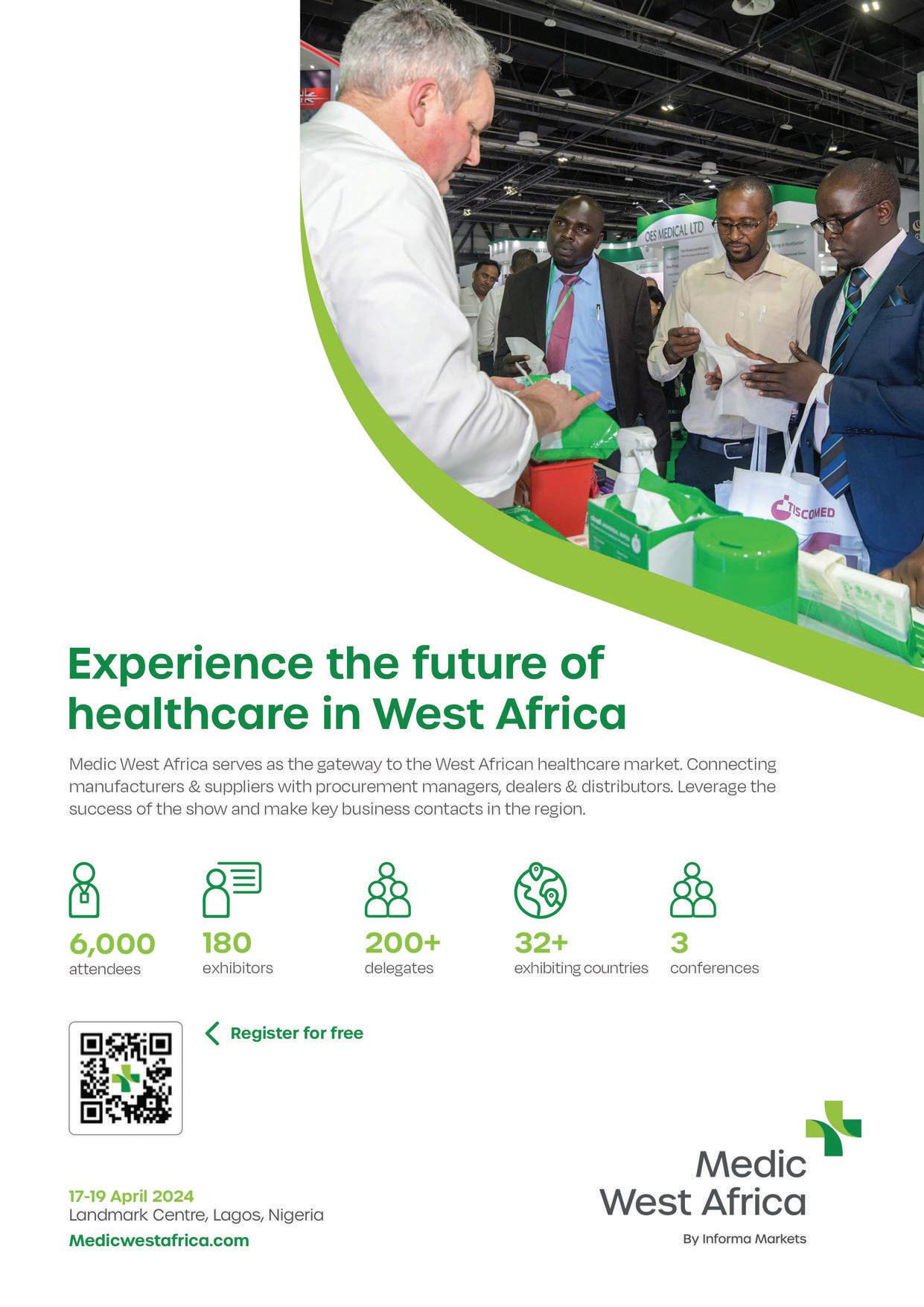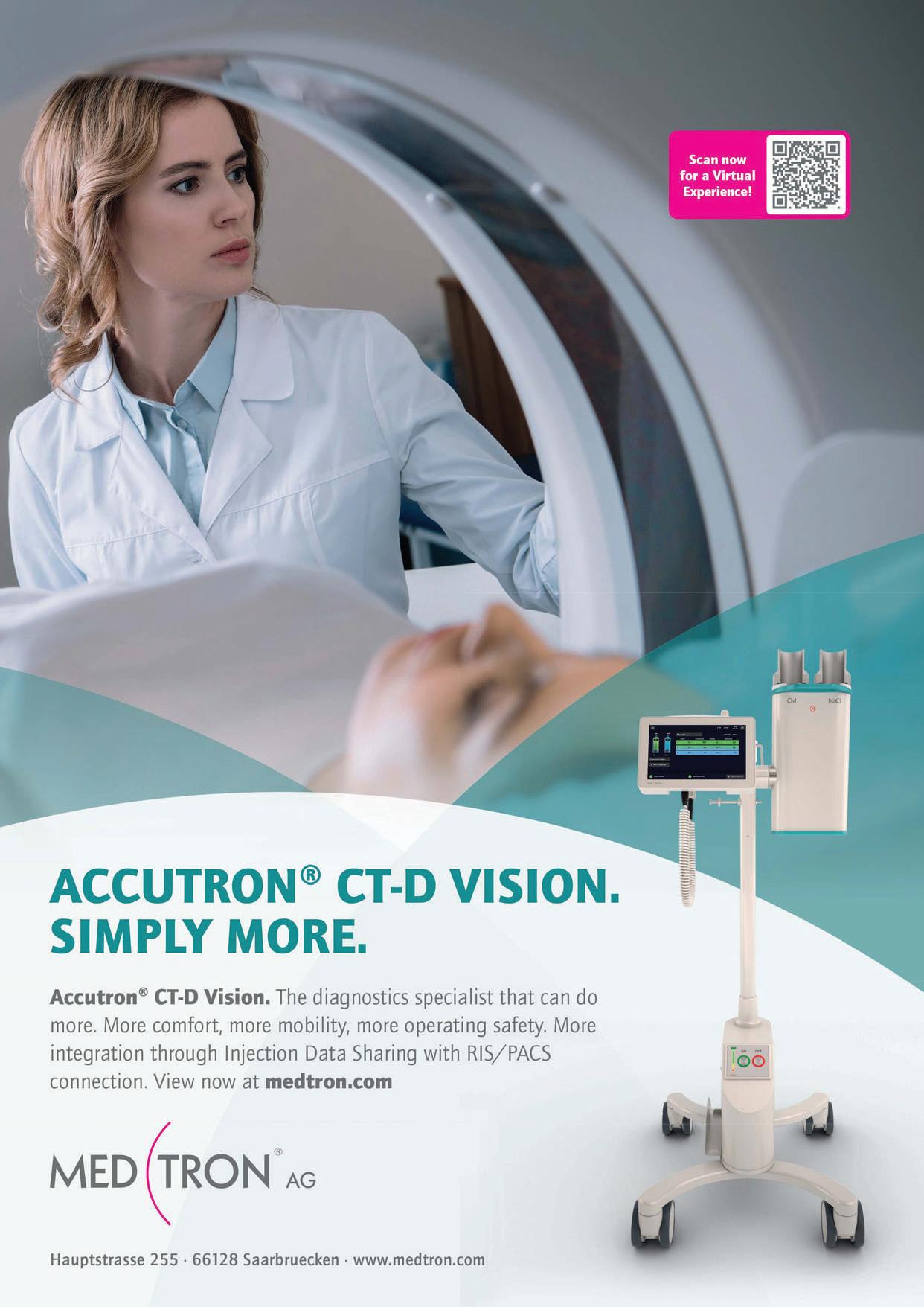Serving the region for over 40 years

March - April 2024


Serving the region for over 40 years

March - April 2024

• Expanded germline gene testing benefits patients
• AI may predict spread of lung cancer to brain
Ultrasound Expert panel calls for increased use of IVUS in peripheral vascular interventions
Embracing MedTech
Philips report shows KSA healthcare leaders put focus on technology, sustainability
In the News
• MBRSG and GCHRAGD collaborate to explore healthcare’s role in peacebuilding initiatives
• One in eight people are now living with obesity
• Leaders call for scale-up in implementing One Health approach
• Consistent evidence links ultra-processed food to over 30 damaging health outcomes
• Bariatric surgery provides long-term blood glucose control, type 2 diabetes remission Bahrain

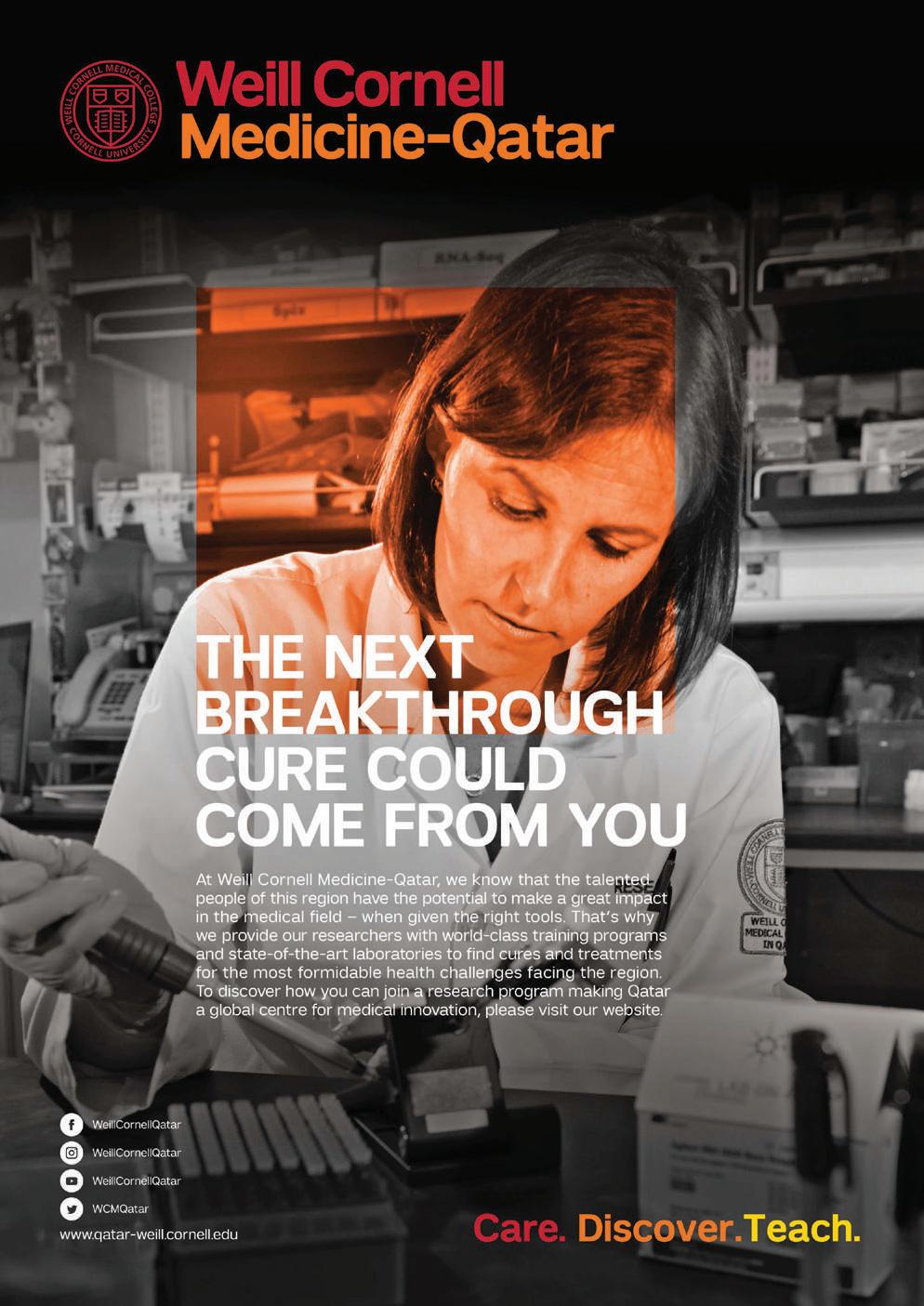


One area of focus in this issue is oncology where we look at some of the latest research in this field. Developments in cancer genetics research, specifically, are providing a ray of hope for a potential cure for cancer. This research also promises a paradigm shift in diagnosis and treatment strategies.
Harnessing the power of advanced technologies such as next-generation sequencing (NGS) and CRISPR-Cas9, scientists are revealing the intricate genetics of various types of cancer, paving the way for personalized therapeutic interventions.
By studying the genetic alterations that drive tumorigenesis, researchers can identify key driver mutations responsible for cancer initiation and progression. This deep understanding enables clinicians to develop targeted therapies tailored to individual patients, thus maximizing treatment efficacy while minimizing adverse effects.
Additionally, the advent of liquid biopsy has revolutionized cancer diagnosis and monitoring. By analyzing circulating tumour DNA (ctDNA) shed by tumours into the bloodstream, clinicians can detect cancer-associated mutations with unprecedented sensitivity and specificity. This non-invasive approach not only facilitates early cancer detection but also enables real-time monitoring of treatment response and disease progression, enabling clinicians to make better informed therapeutic decisions.
Advances in CRISPR-Cas9 technology have opened new avenues for precision cancer therapy. CRISPR-based genome editing enables researchers to precisely modify cancer-associated genes, either by correcting deleterious mutations or by disrupting oncogenic pathways. This revolutionary approach holds great promise for developing novel therapeutic modalities, including gene therapy and immunotherapy, tailored to the genetic makeup of individual tumours.
As we move into an era of precision medicine, integrating multi-omics data – such as genomics, transcriptomics, proteomics, and metabolomics – offers a comprehensive view of cancer biology, and helps in the discovery of molecular networks driving tumorigenesis. By leveraging advanced bioinformatics tools and machine learning algorithms, researchers can decipher complex molecular signatures associated with drug response and resistance, thereby guiding the selection of optimal therapeutic regimens for individual patients.
Collaborative efforts such as The Cancer Genome Atlas and the International Cancer Genome Consortium have amassed vast repositories of genomic data from diverse cancer types. They are fostering global collaboration and accelerating translational research efforts. By sharing data and resources, scientists can study the genetic underpinnings of cancer more rapidly, leading to the development of innovative diagnostic tools and targeted therapies that hold the promise of transforming cancer care.
These latest advancements in cancer genetics research offer a glimmer of hope for patients battling this formidable disease. By unravelling the genetic intricacies of cancer and harnessing the power of precision medicine, researchers are poised to revolutionize cancer diagnosis and therapy, ushering in a new era of personalized oncology tailored to the unique genetic makeup of each patient.
Editor
editor@MiddleEastHealth.com

Publisher
Michael Hurst
Michael@MiddleEastHealth.com
Editor
Callan Emery
editor@MiddleEastHealth.com
Editorial Consultants
Dr Gamal Hammad, Dr Peter Moore, Harry Brewer
Middle East Editorial Office
PO Box 72280, Dubai, UAE
Telephone: (+9714) 391 4775 editor@MiddleEastHealth.com
Marketing Manager
Foehn Sarkar
Telephone: (+9714) 391 4775 n Fax: (+9714) 391 4888 marketing@MiddleEastHealth.com
Subscription & Admin Manager
Savita Kapoor
Telephone: (+9714) 391 4775 n Fax: (+9714) 391 4888
Savita@MiddleEastHealth.com
Advertising Sales
PO Box 72280, Dubai, UAE marketing@MiddleEastHealth.com
Americas, France
Joy Sarkar
P O Box 72280, Building No.2
2nd Floor, Dubai Media City
Dubai, United Arab Emirates
Tel: +971 4 391 4775 Fax: +971 4 391 4888
Joy@MiddleEastHealth.com
Japan
Mr Katsuhiro Ishii
Ace Media Service Inc
12-6, 4-chome, Adachi-ku, Tokyo 121-0824, Japan
Tel: +81-3-5691-3335 n Fax:+81-3-5691-3336
Email: amskatsu@dream.com
China
Miss Li Ying
Medic Time Development Ltd, Flat 1907, Tower A, Haisong Building, Tairan 9th Road, Futian District, Shenzhen, China 518048
Tel: +86-755-239 812 21 n Fax: +86-755-239 812 33
Email: medic8@medictime.com
Taiwan
Larry Wang
Olympia Global Co Ltd
7F, No.35, Sec 3, Shenyang Rd, Taichung
Taiwan 40651 n P O Box: 46-283 Taichung Taiwan 40799
Tel: +886- (4)-22429845 n Fax:+886- (4)-23587689
Email: media.news@msa.hinet.net
Middle East Health is published by Hurst Advertising FZ LLC , Dubai Media City, License Number: 30309
UAE National Media Council - Approval Number: 2294781
Middle East Health online
www.MiddleEastHealth.com
Middle East Health is printed by Atlas Printing Press. www.atlasgroupme.com
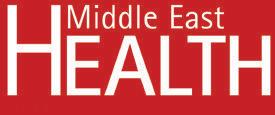





The Dubai branch of BD (Becton, Dickinson, and Company), one of the leading global medical technology companies, and the Emirates Nursing Association (ENA) will collaborate to advance patient safety and healthcare worker protection across the UAE. The groundbreaking initiative will focus on critical areas such as infection prevention, complications reduction, medication management, and ensuring the highest standards in vascular access management.
The partnership was formalized in the form of a Memorandum of Understanding (MoU), that was signed in the presence of Dr Sumaya Al Blooshi, President of the Emirates Nursing Association, ENA members Mariam Rashed Al Mansouri and Mariam Rashed AlSaadi, as well as Maher Elhassan, Vice President and General Manager, BD Middle East, North Africa, and Turkey; and members from both organizations.
The collaboration is set to enhance nursing and midwifery practices through a
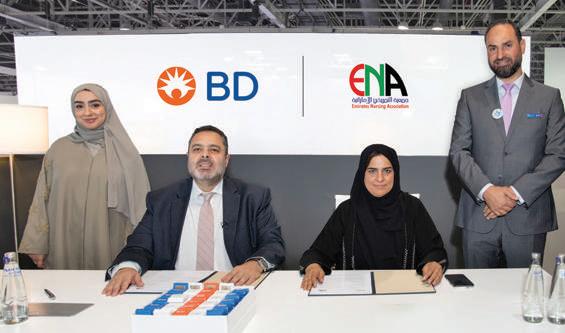
comprehensive approach that encompasses training programmes, community activities, research studies, and the development of national standards and practice guides. Special attention will be given to combating needle-stick injuries and enhancing the quality and efficiency of specimen collection, reflecting a holistic commitment to elevating healthcare standards.
Dr Al Blooshi shared her vision for the partnership: “Collaborating with BD, one of the global leaders in medical technology, enables us to further our mission of promoting excellence in nursing and midwifery. This initiative will empower our healthcare professionals with the knowledge and tools neces-
The Mohammed Bin Rashid School of Government (MBRSG), in partnership with the Geneva Centre for Human Rights Advancement and Global Dialogue (GCHRAGD), hosted an interactive panel discussion to examine the most effective and practical global government practices that can enhance healthcare access as a key element in peace-building processes.
The panel discussion is part of a strategic Memorandum of Understanding (MOU) signed between the parties to encourage educational and research
initiatives in the fields of human rights and governance, leveraging the expertise and international networks of both organizations.
Under the theme “Right to Health and Peacebuilding Amidst Geopolitcal Tensions”, the session focused on integrating healthcare into peace processes and conflict resolution. It emphasized the pivotal role of health and medical sector professionals in these efforts and highlighted the crucial role of women in health services for successful peace processes.
The panel featured multidisciplinary experts from the International Humanitarian
sary to provide the highest standard of care, while also ensuring their safety. We are excited to work together on this transformative project that promises to benefit patients and healthcare workers alike.”
Elhassan commented: “This partnership with the Emirates Nursing Association represents a significant milestone in our ongoing efforts to advance the world of health. By focusing on key areas such as infection prevention and medication management, we are committed to promoting patient safety and supporting the efficiency of healthcare practices. Together, we are poised to make a substantial impact on healthcare outcomes in the UAE.”
City (IHC) in Dubai, Giuseppe Saba, CEO; Dr Umesh Palwankar, Executive Director, Geneva Centre for Human Rights Advancement and Global Dialogue, Geneva, Switzerland; Dr Khulood Alsayegh, Head of Health Policies and Regulation, Dubai Health Authority, Dubai, UAE and Clare Dalton, Head of Delegation, International Committee of the Red Cross, Dubai UAE, moderated by Professor Immanuel Azaad Moonesar, Professor of Health Policy and Systems Research of MBRSG. Panelists discussed the role of healthcare policymakers in t
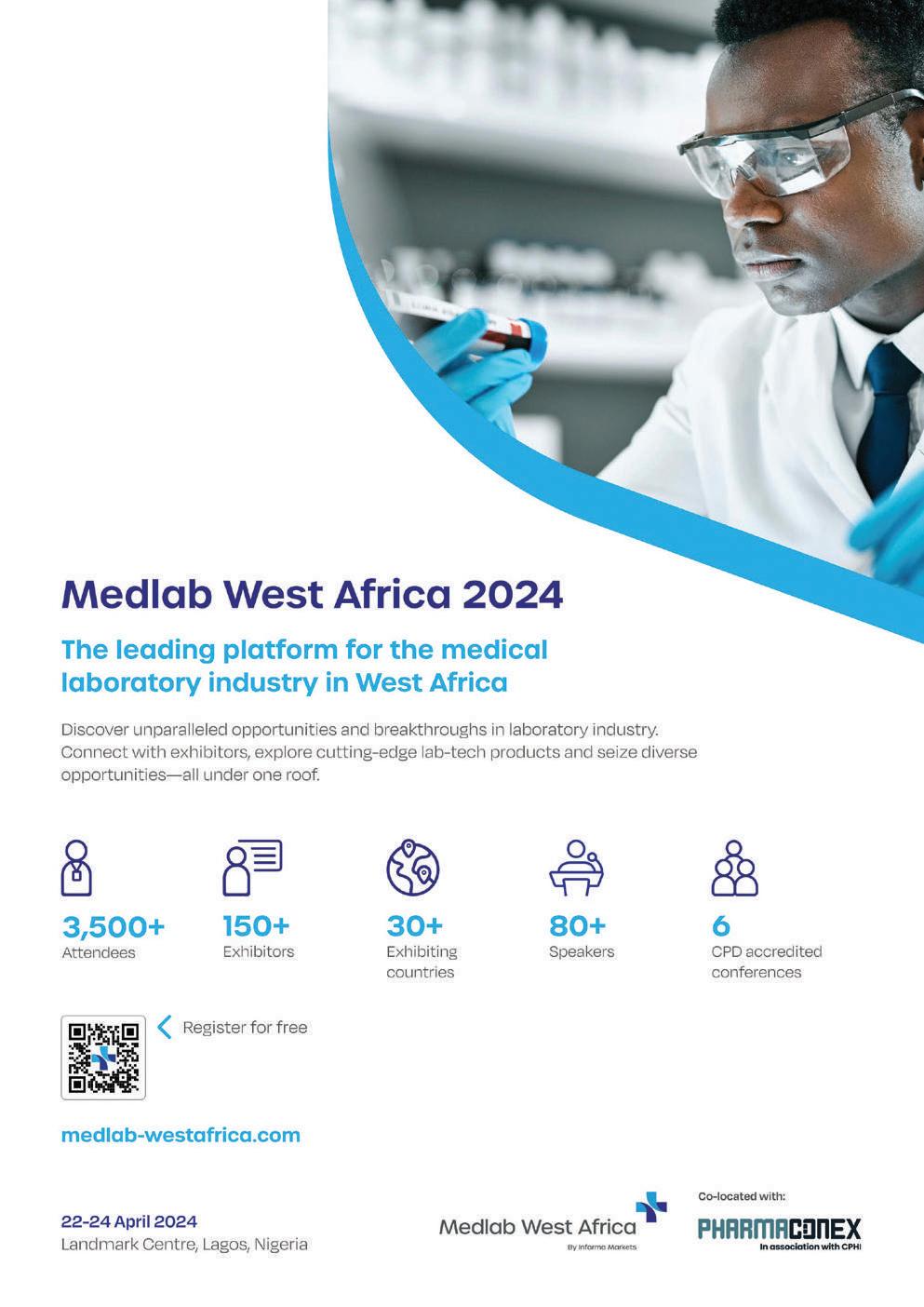
operationalizing health as a bridge to peace through conflict analysis, advocacy, and enhancing capacity building of the health workforce for peace skills and partnerships.
Prof. Moonesar emphasized that the policy council workshop underscored MBRSG’s commitment to fostering global dialogue. The discussion offered vital insights for governments, societal groups, private entities, international allies, and individuals on promoting health rights as a pathway to peace.
Dr Palwankar underscored the critical role of humanitarian law in safeguarding non-combatants in armed conflicts in his
remarks. He stressed the importance of upholding the right to health and physical and moral integrity, ensuring the safety of the wounded, sick, and medical personnel, and protecting medical facilities and transports. Highlighting the severe humanitarian crises, including starvation, disease, and health threats resulting from violations of these principles in conflicts.
Dr Palwankar reinforced the Geneva Centre’s commitment to research, advocacy, and capacity building in human rights. He noted the Centre’s focus on equality, justice, and environmental sustainability and the significant role of its collaboration with MBRSG,
which began even before the formalization of their MoU, in facilitating global dialogues and collaborations through various events and publications.
The panel session identified three potential intervention avenues for health as a bridge for peace programmes – delivering health services in conflict zones, providing a neutral platform to collaborate on health issues, and offering mental health and rehabilitation services to aid reconciliation in conflict-affected communities.
Providing healthcare beyond hospitals is the main focus for a transformative new partnership, as Riyadh-based HoopoeView become the first organisation to deliver Clinitouch in the Middle East.
The remote patient monitoring technology has over a decade of proven results in the UK’s National Health Service (NHS) and enables medical professionals to track people’s health from anywhere, helping to provide enhanced healthcare outside of hospitals.
This new partnership aligns with the Saudi Government’s Healthcare Sector Transformation Programme and ‘Vision 2030’ agenda, which is designed to ensure healthcare delivery is more comprehensive, effective, and integrated.
Through the Clinitouch platform, patients can complete health questionnaires and input vital signs from home, providing real-time remote symptom monitoring that enables more timely interventions. Drawing from Clinitouch’s remote patient monitoring technology success at scale across the NHS, the project aims to improve access to care, helping to minimise clinical overcrowding and reducing strain on hospitals.
HoopoeView and Clinitouch will work together and with clinicians in the region to design dedicated pathways for use in Saudi Arabia, ensuring it meets the everyone’s needs.
The partnership was officially announced at Arab Health in Dubai earlier this year, with senior representatives from HoopoeView and Clinitouch meeting to

sign contracts, supported by the UK’s Department for Business and Trade.
Speaking at the ceremony, Musleh Alchalabi, CEO at HoopoeView, said: “We’re thrilled to officially collaborate with Clinitouch. This partnership marks the beginning of a journey filled with innovation and shared commitment to advancing healthcare.”
Bruce Adams, Commercial Director at Clinitouch, added: “I am thrilled to announce our first partnership in the Middle East with HoopoeView. We’ve been impressed with the team’s passion to make a massive impact on patient care through innovative health technology. This is a hugely exciting opportunity to help patients in Saudi Arabia across multiple health conditions and I am looking forward to seeing the first projects take shape.”
With proven results in the UK since 2011, Clinitouch has long-lasting relationships with the NHS, using remote monitoring technology to connect patients with their clinical teams from home.
The technology is now being expanded into multiple new territories worldwide via a global partnership program that’s backed by the UK’s Department for Business and Trade. This announcement in Saudi Arabia follows previous launches across the UK, India and Namibia, with digital health projects now being designed across 12 countries and five continents.
Companies who are interested in introducing the technology to their respective countries are encouraged to apply for the program.
• For more information about Clinitouch and the Partner Programme, visit: www.clinitouch.com.

PureHealth, the largest healthcare platform in the Middle East, has taken a significant step forward in the UAE healthcare sector by completing the full integration of Sheikh Shakhbout Medical City (SSMC). The UAE’s largest healthcare complex, SSMC was established as part of the Abu Dhabi Economic Vision 2030 to elevate healthcare services in the Emirate. This move further positions PureHealth at the forefront of the region’s healthcare industry and aligns with its goal to establish Abu Dhabi as a major destination in global healthcare.
Recognised for its specialised care and modern facilities, SSMC represents a valuable addition to PureHealth’s existing capabilities. The integration is expected
to bring in an influx of medical expertise, advanced technology, and innovative treatment options.
Hamad Al Hammadi, Chairman of the Board of Directors of PureHealth, said: “The integration of SSMC reflects PureHealth’s dedication to improving healthcare standards, positioning Abu Dhabi as a global healthcare hub. While this is a significant milestone for PureHealth, it also marks a new chapter for healthcare in the region, opening doors for international collaborations, and furthering research and development, leading to groundbreaking initiatives and even more sophisticated healthcare services, solidifying Abu Dhabi’s position as a destination for medical excellence.”
Farhan Malik, Founder and Managing Director of PureHealth, said: “We are pleased
Johns Hopkins Aramco Healthcare (JHAH) recently brought together 170 healthcare professionals, including influential female figures playing a key role in shaping the future of Saudi Arabia’s healthcare sector, at an event marking International Women’s Day (IWD).
Recognizing the remarkable achievements of its female employees, which include more than 1,000 Saudi nationals, JHAH – a joint venture between John Hopkins Medicine and Saudi Aramco – hosted staff and senior leadership at an event titled ‘Invest in Women: Accelerate Progress’.
The event highlighted JHAH’s work promoting an inclusive and empowering environment in line with this year’s IWD theme of “Embrace Equity” in addition to the Kingdom’s vision for a future in which women participate in all sectors.
Since 2015, female labour force participation in Saudi Arabia has nearly doubled to more than 36%, already surpassing Vision 2030’s target of 30% by the end of the
decade. At JHAH, women comprise over 57% of the workforce with the organization setting a precedent for gender equity in Saudi’s healthcare sector. Notably, 106 Saudi women occupy leadership roles within JHAH.
Highlighting the organization’s commitment to promoting women’s leadership and professional growth, Dr Michael Walsh, Chief Executive of JHAH, said: “JHAH is deeply committed to creating an environment where women can excel and reach their full potential. We are immensely proud of all our female colleagues and their significant contributions to the organization and the wider healthcare sector. Their expertise, leadership, and dedication are integral to our mission of delivering world-class healthcare to our patients. That is what we are celebrating at Invest in Women: Accelerate Progress.”
The event was attended by Dr Noha Al Mohaisen, Head of Enablement at CQI & PS, Ministry of Defence Health Ser-
to announce the integration of Sheikh Shakhbout Medical City into our portfolio. SSMC features world-class facilities, renowned medical expertise, cutting-edge technology, and provides one of the most specialised clinical services in the region. With our current network in the UAE, where we cover the complete spectrum from tertiary care to primary care and digitally enabled care, SSMC brings a hub for clinically advanced services with premium quality and clinical outcomes into the network. This synergy extends beyond brand recognition, as the strategic incorporation of SSMC into PureHealth’s eco-system will drive significant operational efficiencies and optimisations, benefitting the entire group and ultimately enhancing patient care across Abu Dhabi and the UAE.”
vices, Riyadh; Dr Hanan Alshaikh, Chair, Women and Child, Health Department at JHAH; Dr Samah Al Fahmi, Pediatric Emergency and Medicine Consultant at Makkah Healthcare Cluster; and Dr Manal Alnaimi, Thoracic Surgery, and Consultant Chief, at King Fahad Specialist Hospital in Dammam, among others.
The event hosted discussions on strategies to enhance women’s participation in healthcare as well as ways of cultivating a more inclusive ecosystem.
Dr Alshaikh, emphasized the importance of hosting events celebrating the achievements of women: “Creating a culture of empowerment and equal opportunities for women in leadership roles is crucial for the sustainable development of the Kingdom’s healthcare sector. In fact, this is true for all sectors that are powering the country’s economic transformation; women empowerment is a prerequisite to achieving the ambitious objectives of Vision 2030.”

Organon, a global healthcare company dedicated to improving women’s health, in partnership with Flat6Labs, MENA’s leading seed and early-stage venture capital firm, has launched the second edition of the Women’s Health Accelerator Program. The initiative aims to empower digital health startups with solutions to enhance women’s health across the Middle East, North Africa, and Turkey (MENAT) region.
The launch follows the overwhelming success of the inaugural Accelerator Program, where three standout female-founded digital health start-ups were honoured in MENA as winners: “OMGYNO” founded by Doreen Toutikian and Elisabeth Milini in Greece and Lebanon, “Siira” founded by Sandra Salame in Lebanon, and “Maternally” founded by Yasmin El Mouallem in the UAE. The accelerator initiative was launched to address specific health challenges faced by women in the region, aiming to find sustainable and long-term solutions. These visionary companies have not only demonstrated innovation and excellence but have also become integral parts of the health ecosystem.
The second edition of the programme focusses on innovation across three areas of women’s health, including family planning, fertility, and women’s wellness. The emphasis is on digital solutions that
can help improve accessibility, empower individuals, and enhance overall quality of well-being, ultimately advancing women’s healthcare.
Ramy Koussa, Associate Vice President for Middle East, North Africa & Turkey at Organon, said: ”Launching the second edition of the Women’s Health Accelerator Program marks a significant milestone in our ongoing commitment to advancing women’s health in the MENAT region. Investing in improving women’s health not only improves women’s quality of life but also enables them to thrive in the workforce. Therefore, we want to support entrepreneurs to drive forward the next wave of innovations and solutions.”
He further commented: “We are excited to deepen our partnership with Flat6Labs and continue listening to the needs of women, identifying innovative solutions that foster a better and healthier every day for her. This edition is a testament to our sustained dedication to collaboration, innovation, and the empowerment of women and startups who have new digital solutions in the women’s health space.”
Yehia Houry, Chief Programs Officer at Flat6Labs, emphasized the importance of supporting entrepreneurs and advancing women’s healthcare, saying: “As we embark on the second edition of the Women’s Health Accelerator Program, we are
thrilled to amplify our support for entrepreneurs shaping the future of women’s healthcare. This initiative is not just about innovation; it’s about empowering visionary minds to create lasting impact. Our ongoing partnership with Organon and the evolving focus of this edition reaffirm our commitment to fostering a dynamic ecosystem for women-led startups. Together, we aim to revolutionize the healthcare landscape, ensuring it reflects the diverse and nuanced needs of women across the MENAT region.”
As well as improving exposure and visibility to key stakeholders in the healthcare sector, the programme will include community events, such as specialized training sessions and seminars to enhance the exchange of ideas and experiences in commercial and technical aspects, which will contribute to providing startups with the knowledge and skills necessary to expand the scope of their business.
The three core focus areas include family planning, utilizing technologies to offer advice and raise awareness about various family planning methods available to women. Secondly, fertility planning, honing in on solutions for IVF mental health support and counselling. Thirdly, innovations that benefit women’s wellness, with a particular focus on self and maternal care, disease prevention and menstrual health.
For more information about the Women’s Health Accelerator Program’s second edition and the application process, visit the website < https://www.flat6labs.com/program/womens-health-accelerator-program/ >.
The applications close on May 16, 2024. The countries in the programme include UAE, Kuwait, Lebanon, Oman, Turkey, Egypt, Jordan and Saudi Arabia.

The responsible and prudent use of antimicrobials needs to be improved in all sectors – human, animal, plant/crop, and environment – to preserve their public health benefits. In particular, antimicrobials that are medically important for human medicine need to be preserved by reducing their use in the non-human sectors. The WHO list of medically important antimicrobials for human medicine (WHO MIA List) is a risk management tool that can be used to support decision-making to minimize the impact of antimicrobial use in non-human sectors on antimicrobial resistance (AMR) in humans.
The WHO MIA List is created to guide international, national, and subnational (local, state, provincial) antimicrobial stewardship efforts. It complements the WHO AWaRe (Access, Watch, Reserve) framework and antibiotic book which provide guidance on appropriate use of essential antibiotics within the human health sector.
The list categorizes antimicrobial classes based on their importance for human medicine and according to the AMR risk and potential human health implications of their use in non-human sectors: critically important, highly important, and important to human medicine. The publication is intended to serve as a refer-
ence tool to support decision-making by national regulators and policymakers in ministries of health and agriculture, authorities responsible for regulating, monitoring, and assuring the responsible and prudent use of antimicrobials, and professional prescribers in different sectors.
The WHO MIA List was developed in close collaboration with the Food and Agriculture Organization (FAO), the United Nations Environmental Programme (UNEP) and the World Organisation for Animal Health (WOAH) as a joint effort to harmonize and align related guidance and lists developed by the four organizations. Best practice statements included in the document are aligned with the position of the Quadripartite organizations (FAO, UNEP, WHO, and WOAH) and are critical to preserving the effectiveness of the agents in the WHO MIA List. Further work is ongoing to harmonize guidance on the prudent use of antimicrobials across all four organizations and this WHO antimicrobial list and the WOAH List of antimicrobial agents of veterinary importance.
AMR remains one of the top global public health threats facing humanity and was associated with the death of close to 5 million people globally in 2019. AMR occurs when bacteria, viruses, fungi, and parasites change over time and no longer

respond to antimicrobial medicines making infections harder to treat and increasing the risk of disease spread, severe illness, and death. As a result, antimicrobial medicines become ineffective and infections persist in the body, increasing the risk of transmission to others. The WHO MIA List supports the optimized use of
• Download the WHO list of medically important antimicrobials for human medicine https://cdn.who.int/media/docs/default-source/gcp/who-mia-list-2024-lv.pdf
Adopting a One Health approach that recognizes the health of people is closely connected to the health of animals and our shared environment offers promising solutions for addressing unprecedented challenges.
Speaking at the Second Quadripartite Executive Annual Meeting in Nairobi, Kenya, on 29 February, WHO’s DirectorGeneral Dr Tedros Adhanom Ghebreye-
sus said: “We need sustained political will to ensure One Health principles are embedded in national and international policies. Implementation in countries; resource mobilization; science and evidence; and political will. These are the four priorities that we must pursue together in the year ahead.”
Leaders of the four organizations of the Quadripartite collaboration on One Health – the UN Food and Agriculture Organiza-
tion, the UN Environment Programme, the World Health Organization, and the World Organisation for Animal Health have worked together to advance the One Health approach worldwide.
In the meeting, the organizations reaffirmed their commitment to further enhance the plan’s policy impact and mobilize sustainable resources to support One Health implementation at all levels. t


Continued from Page 12
The One Health Joint Plan of Action <www.who.int/publications-detailredirect/9789240059139> launched in 2022 is designed to integrate systems and capacity so that we can collectively better prevent, predict, detect, and respond to health threats. Ultimately, this initiative seeks to improve the health of humans, animals, plants, and the environment, while contributing to sustainable development.
The newly launched One Health Joint Plan of Action Implementation Guide <https://www.who.int/publications-detailredirect/9789240082069> is a cornerstone of the global efforts, providing practical guidance for translating One Health theory into action. The One Health High Level Expert Panel collated existing resources and tools developed the One Health inventory list for the Guide.
“The ultimate goal and value of our One
Royals from across the globe are set to convene at the Alzheimer’s Disease International Global Conference < https:// adiconference.org/programme > in Kraków 24-26 April, the longest running international conference on dementia, with both Her Majesty The Queen Sofía of Spain and Her Royal Highness Princess Muna Al Hussein of Jordan confirmed to attend.
Coming at a critical time where 141 dementia drugs are in clinical trials < https:// pubmed.ncbi.nlm.nih.gov/37251912 >, the attendance of the royals is imperative to draw attention to key dementia challenges that are more urgent than ever.
These include concerningly low rates of dementia diagnoses (up to three quarters of cases go undiagnosed according to Alzheimer’s Disease International), which may limit access to dementia treatments when they become available, and limited access to post-diagnosis care (up to 85 percent of cases do not receive post diagnosis care, according to Alzheimer’s Disease International).
Since 2018, ADI has been honoured to count Her Majesty Queen Sofía as an Honorary Ambassador. Her Majesty, a 2015 nominee for the Nobel Peace Prize, has long had a keen interest in Alzheimer’s and dementia.
“I am committed to championing a global response to dementia. Having witnessed healthcare challenges first hand, I know how important is to highlight these issues at global
level. The ADI conference is a critical opportunity to discuss the role of these new developments in conjunction with caregiving and support. We need examples of good practice and innovation from all over the world,” said Her Majesty Queen Sofía.
ADI’s newest Honorary Ambassador, Her Royal Highness Princess Muna, is an internationally renowned figure in global health, a strong advocate for programmes that support the Sustainable Development Goals, former commissioner at the highlevel Commission on Health Employment and Economic Growth and a recipient of numerous distinguished awards for her exceptional leadership in advancing health care for all by all.
HRH Princess Muna is the founder and president of the Jordanian Nursing Council and serves as the WHO’s patron of nursing and midwifery in the Eastern Mediterranean Region.
“Dementia impacts millions worldwide, but the increase in people affected is particularly acute in the Middle East and North Africa. As Honorary Ambassador, I’m committed to lend my voice to dementia causes, for affected individuals, families, and carers at the Kraków conference,” she said.
According to research conducted by ADI < https://www.alzint.org/resource/ world-alzheimer-report-2019 >, two thirds of healthcare providers worldwide still wrongly believe that dementia is a normal part of ageing, and 40 percent of the general pub-
Health collaboration lie in effecting positive changes at the country level,” said Dr Amina Benyahia, Head a.i. WHO One Health Initiative. “By empowering countries, strengthening health systems, and fostering cross-sectoral collaboration, we have the opportunity to drive transformative change from the ground up to achieve improved health and well-being globally.”

lic believe doctors and nurses ignore people with dementia. This research on ‘attitudes to dementia’ is set to be conducted again this year, targeting over 70,000 responses, with a release scheduled for World Alzheimer’s Month in September.
ADI Chief Executive Officer, Paola Barbarino, says she is immensely grateful that the royals are willing to lend their voices to people living with dementia, who across the globe often find their opinions ignored.
“There are over 55 million people living with dementia globally, a figure set to increase to 139 million by 2050, and we know that often they are not heard,” says Barbarino. “In attending our global conference in Kraków, our Royal Ambassadors are not only amplifying the voices of those living with dementia globally but shining a light on Alzheimer’s disease and dementia, challenging the stigma that surrounds them and normalising the conversation.”
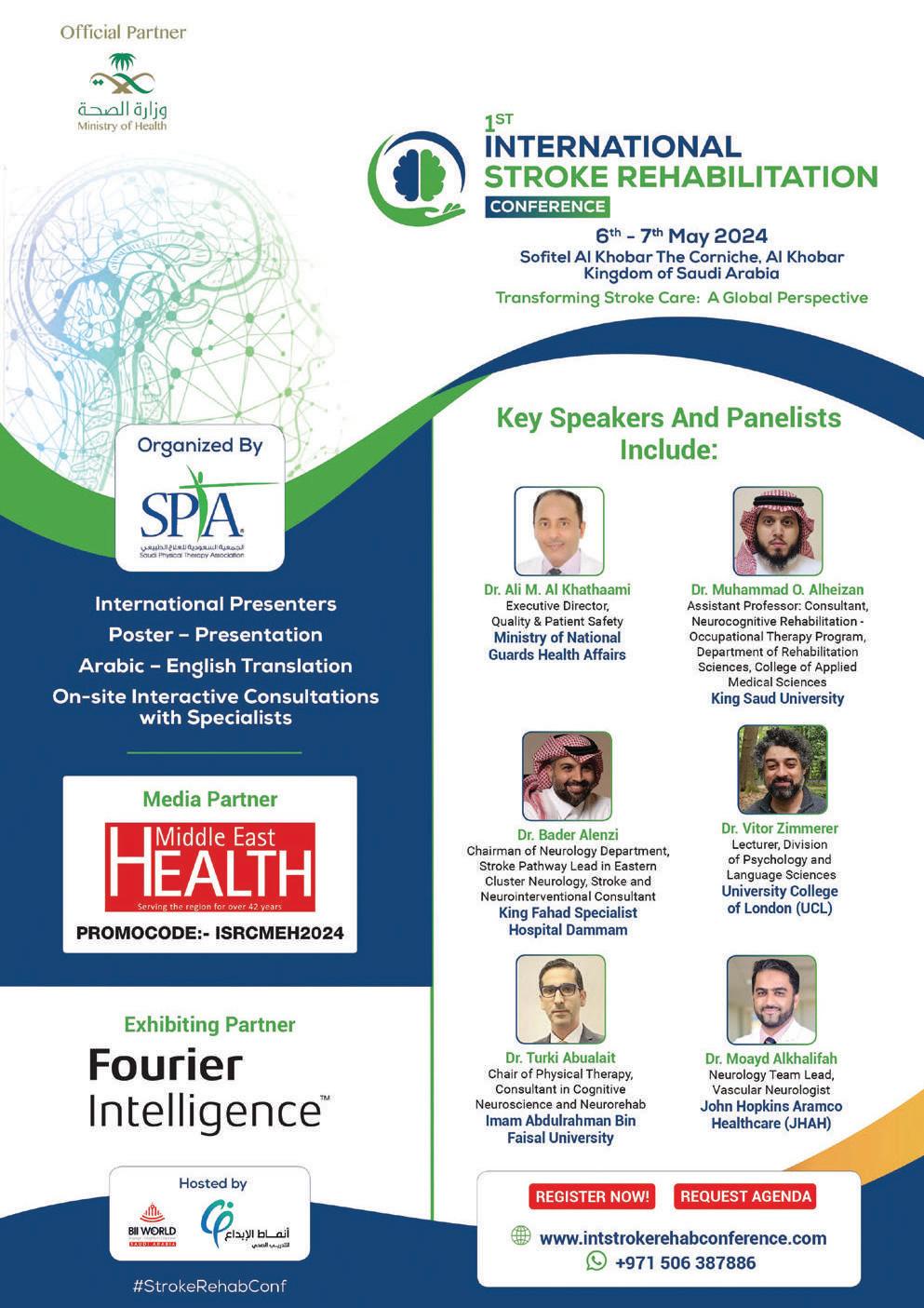


From 11 to 13 December 2023, the Global Influenza Programme of the World Health Organization (WHO), in collaboration with WHO regional offices, the Abu Dhabi Public Health Centre and the Ministry of Health of the United Arab Emirates, held a pivotal meeting on how best to strengthen and expand the activities of the Global Influenza Surveillance and Response System (GISRS).
Established over 70 years ago, GISRS remains a key WHO initiative serving as the world’s network for monitoring influenza viruses, providing recommendations on seasonal vaccine composition in both the northern and southern hemispheres, strengthening laboratory surveillance, and acting as a global alert mechanism for the emergence of viruses with pandemic potential.
This meeting brought together around 120 laboratory and surveillance experts, and health officials from 62 countries to develop and define the scope and objectives of an expanded GISRS – the so-called “e-GISRS” concept. Leveraging decades of experience and grounded in the longestablished GISRS network, e-GISRS will monitor and respond to any epidemic and pandemic threats posed not only by influenza viruses but by other respiratory viruses too. This natural expansion of the scope
of GISRS started in 2015 when respiratory syncytial virus (RSV) was first included in the GISRS platform. This process was then greatly accelerated in 2020 following the emergence of SARS-CoV-2 and the COVID-19 pandemic.
As the world advances towards 100 years of collaboration in fighting the deadly menace of respiratory disease outbreaks, e-GISRS will provide an even stronger global foundation for the vital surveillance, preparedness and response efforts needed to protect the world from constantly evolving respiratory viruses.
Drawing on lessons learned from the COVID-19 pandemic, the above meeting was informed by two previous WHO global consultations:
https://www.who.int/publications/i/item/ WHO-WHE-GIH-GIP-2021.1
https://www.who.int/publications/i/ item/9789240050228
The primary meeting objectives were:
1. To consider how best to adapt integrated surveillance practices for influenza and other priority respiratory viruses (that is, novel viruses or known viruses with epidemic or pandemic potential).
2. To identify and discuss gaps and needs when expanding activities beyond influenza, including the envisaged functions and objectives of e-GISRS and its
coordination with other surveillance systems and networks.
In order to achieve the meeting objectives, two technical workstreams had been initiated prior to the meeting to review evidence and existing guidance, and to discuss the laboratory and epidemiological standards needed for effective influenza, RSV and SARS-CoV-2 surveillance. A third workstream had also been implemented to address issues surrounding coordination gaps and needs of e-GISRS for the surveillance of non-influenza respiratory viruses.
During group and panel discussions, integrated surveillance practices were reviewed, and inputs sought on how best to operationalize the standards and address the needs identified by the workstreams. In addition, the crucial role of international cooperation in strengthening global surveillance and response capabilities against all respiratory viruses was highlighted, along with the need to ensure collaborative approaches to emerging health challenges. A number of immediate next steps were also identified, including the revision of current WHO guidance on integrated surveillance.
This pivotal meeting reaffirmed the spirit of collaboration and trust which has been the hallmark of GISRS for over 70 years, while also bringing into sharper focus the strengthened, expanded and shared vision for advancing GISRS.


A new study released by The Lancet shows that, in 2022, more than 1 billion people in the world were living with obesity. Worldwide, obesity among adults has more than doubled since 1990, and has quadrupled among children and adolescents (5 to 19 years of age). The data also show that 43% of adults were overweight in 2022.
The study also shows that even though the rates of undernutrition have dropped, it is still a public health challenge in many places, particularly in South-East Asia and sub-Saharan Africa.
Countries with the highest combined rates of underweight and obesity in 2022 were island nations in the Pacific and the Caribbean and those in the Middle East and North Africa.
Malnutrition, in all its forms, includes undernutrition (wasting, stunting, underweight), inadequate vitamins or minerals, overweight and obesity. Undernutrition is responsible for half of the deaths of children under 5 and obesity can cause noncommunicable diseases such as cardiovascular diseases, diabetes and some cancers.
WHO has contributed to the data collection and analysis of this study. The full dataset is now also disseminated through the Global Health Observatory < www.who.int/data/gho >.
“This new study highlights the importance of preventing and managing obesity from early life to adulthood, through diet, physical activity, and adequate care, as needed,” said Dr Tedros Adhanom Ghebreyesus, WHO Director-General. “Getting back on track to meet the global targets for curbing obesity will take the work of governments and communities, supported by evidence-based policies from WHO and national public health agencies. Importantly, it requires the cooperation of the private sector, which must be accountable for the health impacts of their products.”
Obesity is a complex chronic disease. The causes are well understood, as are the interventions needed to contain the crisis, which are backed by strong evidence. However, they are not implemented. At the World Health Assembly in 2022 Member States adopted the WHO Acceleration plan to stop obesity, which supports country-level action through 2030. To date, 31 governments are now leading the way to curb the obesity epidemic by implementing the plan.
The core interventions are:
• actions to support healthy practices from day 1, including breastfeeding promotion, protection and support;
• regulations on the harmful marketing of food and beverages to children;
• school food and nutrition policies, including initiatives to regulate the sales of products high in fats, sugars and salt in proximity of schools;
• fiscal and pricing policies to promote healthy diets;
• nutrition labelling policies;
• public education and awareness campaigns for healthy diets and exercise;
• standards for physical activity in schools; and
• integration of obesity prevention and management services into primary health care. “There are significant challenges in implementing policies aimed at ensuring affordable access to healthy diets for all and creating environments that promote physical activity and overall healthy lifestyles for everyone,” said Dr Francesco Branca, Director of WHO’s Nutrition and Food Safety Department and one of the co-authors of the study. “Countries should also ensure that health systems integrate the prevention and management of obesity into the basic package of services.”
Addressing undernutrition requires multisectoral action in agriculture, social protection and health, to reduce food insecurity, improve access to clean water and sanitation and ensure universal access to essential nutrition interventions.
The World Health Organization (WHO) signed a memorandum of understanding with the International Association of Medical Regulatory Authorities (IAMRA) <www.iamra.com>, which supports medical regulators around the world to exchange best practice through scientific, educational and collaborative activities.
The agreement was signed by WHO Director-General Dr Tedros Adhanom Ghebreyesus and Joan Simeon, Chair of IAMRA, who was joined by IAMRA secretary Dr Humayun Chaudhry and Dr Jeffrey Carter, Chair of the Federation of State Medical Boards of the United States.
Through the memorandum of understanding, WHO and IAMRA will work to strengthen health workforce regulation us-
ing research and identifying evidence gaps, providing technical support to increase regulatory capacity in countries, honing understanding of issues faced in low- and middle-income countries through increased participation and collaboration with their regulators, and support for the implementation and uptake of the WHO Guidance on Health Practitioner Regulation.
The MoU framework formalizes the collaboration between the two organizations. “The signing is the culmination of a lot of work between IAMRA and the WHO,” said Joan Simeon, who is also the chief executive officer of Te Kaunihera Rata o Aotearoa Medical Council of New Zealand. “IAMRA looks forward to utilizing the resources and expertise of the WHO in advancing our
jointly held strategic goals in medical and health professional regulation. By working more closely with WHO in information sharing and priority driven programmes, we are confident we can help achieve more effective medical regulation worldwide and through our support of regulatory activities in low and middle-income countries.”
“We are delighted to enter into this agreement with IAMRA and work together to strengthen health professional regulation to ensure everyone in every country gets access to the best possible health care,” Dr Tedros said. “We look forward to continuing and enhancing our strong professional relationships with IAMRA, which will benefit our shared goals of international collaboration to ensure a safe and competent global health workforce.”



In the space of just a few seconds, a person walking down a city block might check their phone, yawn, worry about making rent, and adjust their path to avoid a puddle. The smell from a food cart could suddenly conjure a memory from childhood, or they could notice a rat eating a slice of pizza and store the image as a new memory.
For most people, shifting through behaviours quickly and seamlessly is a mundane part of everyday life.
For neuroscientists, it’s one of the brain’s most remarkable capabilities. That’s because different activities require the brain to use different combinations of its many regions and billions of neurons. How it manages to do this so rapidly has been an open question for decades.
In a paper published March 8 in Nature Human Behaviour [1], a team of researchers, led by Joshua Jacobs, associate professor of biomedical engineering at Columbia Engineering, shed new light on this question. By carefully monitoring neural activity of people who were recalling memories or forming new ones, the researchers managed to detect how a newly appreciated type of brainwave – traveling waves – influences the storage and retrieval of memories.
“Broadly, we found that waves tended to move from the back of the brain to the front while patients were putting something into their memory,” said the paper’s co-author Uma R. Mohan, a postdoctoral researcher at NIH and former postdoctoral researcher in the Electrophysiology, Memory, and Navigation Laboratory at Columbia Engineering. “When patients were later searching to recall the same information, those waves moved in the opposite direction, from the front towards the back of the brain,” she said.
In the brains of some of the study’s 93 participants, waves travelled in other directions.
Honghui Zhang
“There was a lot of diversity across patients, so we implemented a framework based on the direction an individual’s oscillations ‘preferred’ to travel,” Mohan said.
The researchers say these findings advance fundamental neuroscience research and point toward diagnostic and therapeutic approaches for memory-related disorders.
“We think the work may lead to new approaches for interfacing with the brain. By measuring the direction that a person’s brain waves move, we may be able to predict their behaviour,” Jacobs said.
Brain waves are patterns of electrical oscillations that reflect the state of hundreds or thousands of individual neurons at a particular moment. One major question, which remains unsettled, is whether brain waves drive activity or simply occur as a byproduct of neural activity that was already happening. Researchers who study brain waves have tended to treat them as a stationary phenomenon that occurs in a particular region, noting when oscillations in multiple regions seem synchronized.
In this study, Mohan and her colleagues contribute to a growing understanding of these oscillations differently, as “traveling waves” that spread across the brain’s cortex, the outermost layer that supports higher cognitive processing. Mohan compares the traveling waves to the ripples that would spread outward after a pebble was thrown into a pond.
“We’re looking at neural oscillations not as independent stationary things but as things that are constantly and spontaneously moving across the brain in a dynamic
way,” Mohan said.
This relatively new way of understanding brain waves is an exciting step in neuroscience because it offers a pathway to explaining how the brain quickly coordinates activity and shares information across multiple regions.
This study drew on data from participants who were being treated for drug-resistant epilepsy at hospitals across the United States. The experiments occurred while the participants had grids or strips of electrodes temporarily implanted on the surface of the brain, beneath the skull, to determine where the patients’ seizures arise. For the researchers, these electrodes offer the chance to perform experiments that wouldn’t otherwise be feasible.
“It’s a rare opportunity to be able to see what’s going on directly from the brain while the participants are engaged in different cognitive behaviours,” Mohan said.
During the experiments, researchers recorded the participants’ brain activity while they performed tasks that required memorizing and recalling lists of words or letters.
After the experiments, the researchers analyzed the brain activity from each participant in the context of what they were doing in the memory task and how well they performed.
“I implemented a method to label waves traveling in one direction as basically ‘good for putting something into memory.’ Then we could see how the direction switched over the course of the task,” Mohan said. This method builds on previous research from the Jacobs lab by expanding the mathematical framework used to make sense of the vast quantities of data these experiments produced.
“The waves tended to go in the participant’s encoding direction when that participant was putting something into memory and in the opposite direction right before they recalled the word,” she said. “Overall, this new work links travelling waves to behaviour by demonstrating that traveling waves propagate in different directions across the cortex for separate memory processes.”
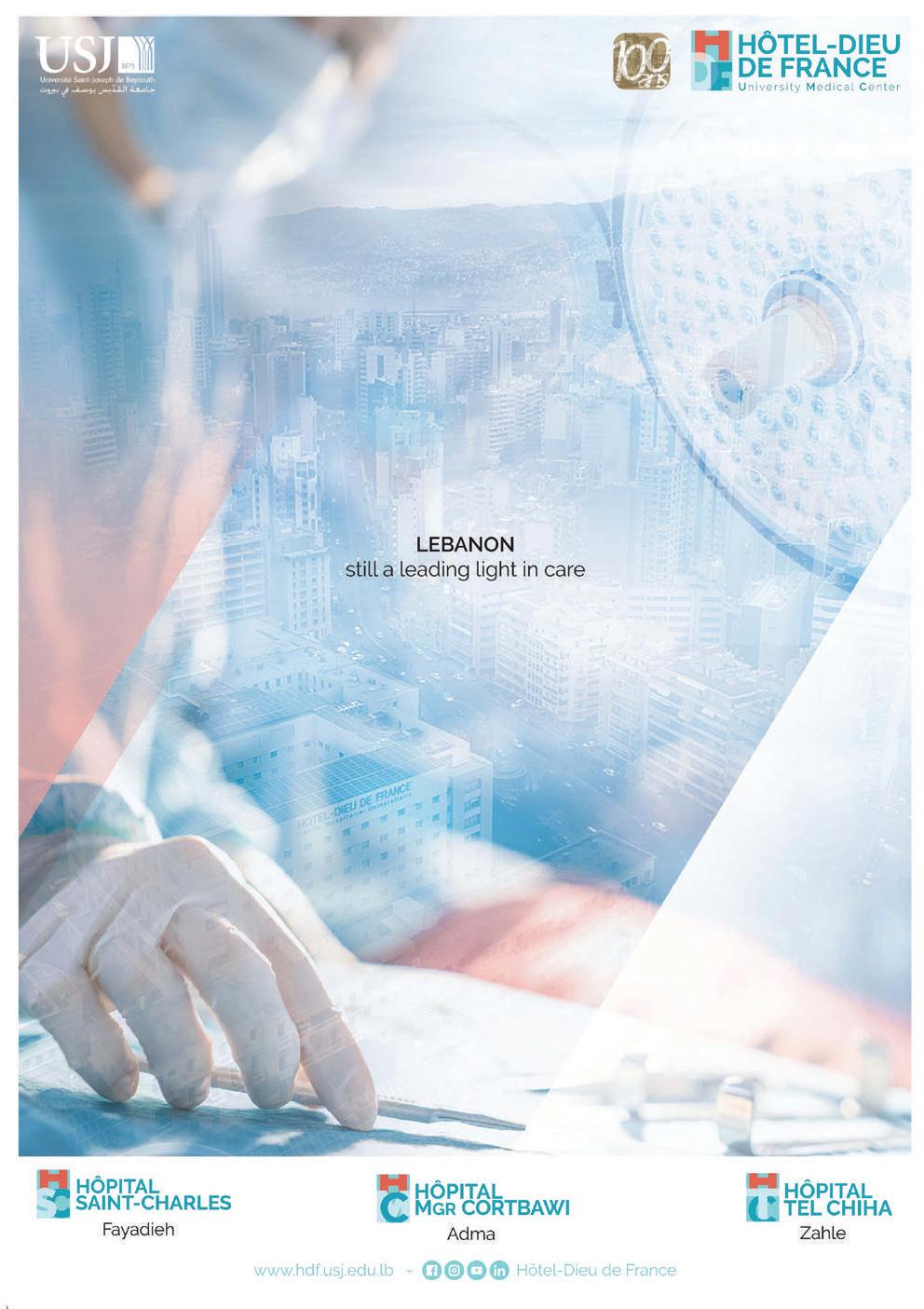

The data also showed that participants tended to perform the memory task more accurately when the traveling waves were moving in the appropriate direction for memory storage and recall.
“These findings shed light on the mechanisms that underlie memory processing. More broadly, they help us better understand how the brain supports a wide range of behaviours that involve precisely coordinated interactions between brain regions,” Mohan said.
As traveling waves are increasingly well understood, they could be the basis for a new class of diagnostic tools that recognize
abnormal patterns in brain activity.
There is also significant therapeutic potential.
“If someone’s waves are moving in the wrong direction when they’re about to try to remember something, that might put them in a poor memory state,” Mohan explained. “If you could apply stimulation in the right way, you could maybe push those waves to move in a different direction, bringing about a fundamentally different memory state.”
Advances in understanding traveling waves offer significant potential for hu-
man-computer interaction.
In terms of both research and application, Mohan notes that memory is just the starting point.
“I am interested in how characteristics of cortical travelling waves change to support a wide range of cognitive functions, including attention and associative memory,” she said.
“The direction of travelling wave propagation may tell us where information is moving across the brain at each moment, showing us how different parts of the brain transfer information during behaviour,” Jacobs said.
Reference:
1. Mohan, U.R., Zhang, H., Ermentrout, B. et al. The direction of theta and alpha travelling waves modulates human memory processing. Nat Hum Behav (2024). https://doi.org/10.1038/s41562-024-01838-3
People with type 2 diabetes who underwent bariatric surgery achieved better long-term blood glucose control compared to people who received medical management plus lifestyle interventions, according to a new study published in JAMA [1]. The participants who underwent bariatric surgery were also more likely to stop needing diabetes medications and had higher rates of diabetes remission up to 12 years post-surgery.
“While there are many factors involved, and not all of them are completely understood, bariatric surgery typically results in greater weight loss that effects a person’s metabolic hormones, which improves the body’s response to insulin and ability to maintain healthy blood glucose levels,” said Dr Jean Lawrence, NIDDK (US National Institute of Diabetes and Digestive and Kidney Diseases) project scientist. “These results show that people with overweight or obesity and type 2 diabetes can make long-term, improvements to their health and change the trajectory of their diabetes through surgery.”
The current study is a follow-up that combined data from four independent singlecentre randomized trials conducted at clinical sites in the United States. The original trials, which were conducted between May 2007 and August 2013, evaluated the effectiveness of bariatric surgery compared to intensive lifestyle and medication therapy involving oral and injectable diabetes medications includ-
ing insulin, for adults with type 2 diabetes and overweight or obesity. While some participants in the study were prescribed GLP-1 agonists as part of their medical management of diabetes, these drugs were not specifically examined in the study. The investigators from the four individual studies pooled their data to provide a larger and more geographically diverse data set to evaluate efficacy, durability, and safety of bariatric surgery to treat type 2 diabetes. Follow-up data were collected through July 2022.
In total, 262 participants from the four original studies enrolled in the current study. Of these, 166 were randomized to surgery and had undergone one of three bariatric surgery procedures. The remaining 96 participants were randomized to the medical/lifestyle management group. The medical/lifestyle interventions have previously been shown effective for weight loss. All participants were between the ages 18 and 65 and had overweight or obesity as measured by body mass index. Primary endpoint results were measured at seven years, with continued follow-up through 12 years.
At seven years, participants in the surgery group experienced an average 20% weight loss compared to 8% in the medical/lifestyle group. The surgery group had greater improvements in blood glucose control, measured by HbA1c, with 54% of participants in the surgery group achieving an HbA1c less than 7% compared to only 27% of par-
ticipants in the medical/lifestyle group. More participants with surgery achieved diabetes remission compared to participants the medication/lifestyle group, and the percent of participants using medications to treat diabetes in the surgery group decreased from 98% to 61%, yet remained largely unchanged in the medication/lifestyle group.
The results and differences between groups remained significant at 12 years.
Additional exploratory analyses in this study showed that bariatric surgery had important, beneficial effects on HbA1c and weight loss among participants with a BMI between 27 and 34 (within overweight and lower obesity ranges).
“These findings lend important information about the benefit of surgery in people with type 2 diabetes who fall short of the traditional, higher BMI threshold of 35 for bariatric surgery,” said Dr Anita P. Courcoulas, chief of Minimally Invasive Bariatric and General Surgery at the University of Pittsburgh Medical Center and lead author of the study.
No differences in major adverse events occurred between the two groups, but there was a higher number of fractures, anaemia, low iron, and gastrointestinal events in the surgery group. Nutritional deficiencies may explain fractures and anaemia, underscoring the importance of continued monitoring of people who have bariatric surgery.
Reference:

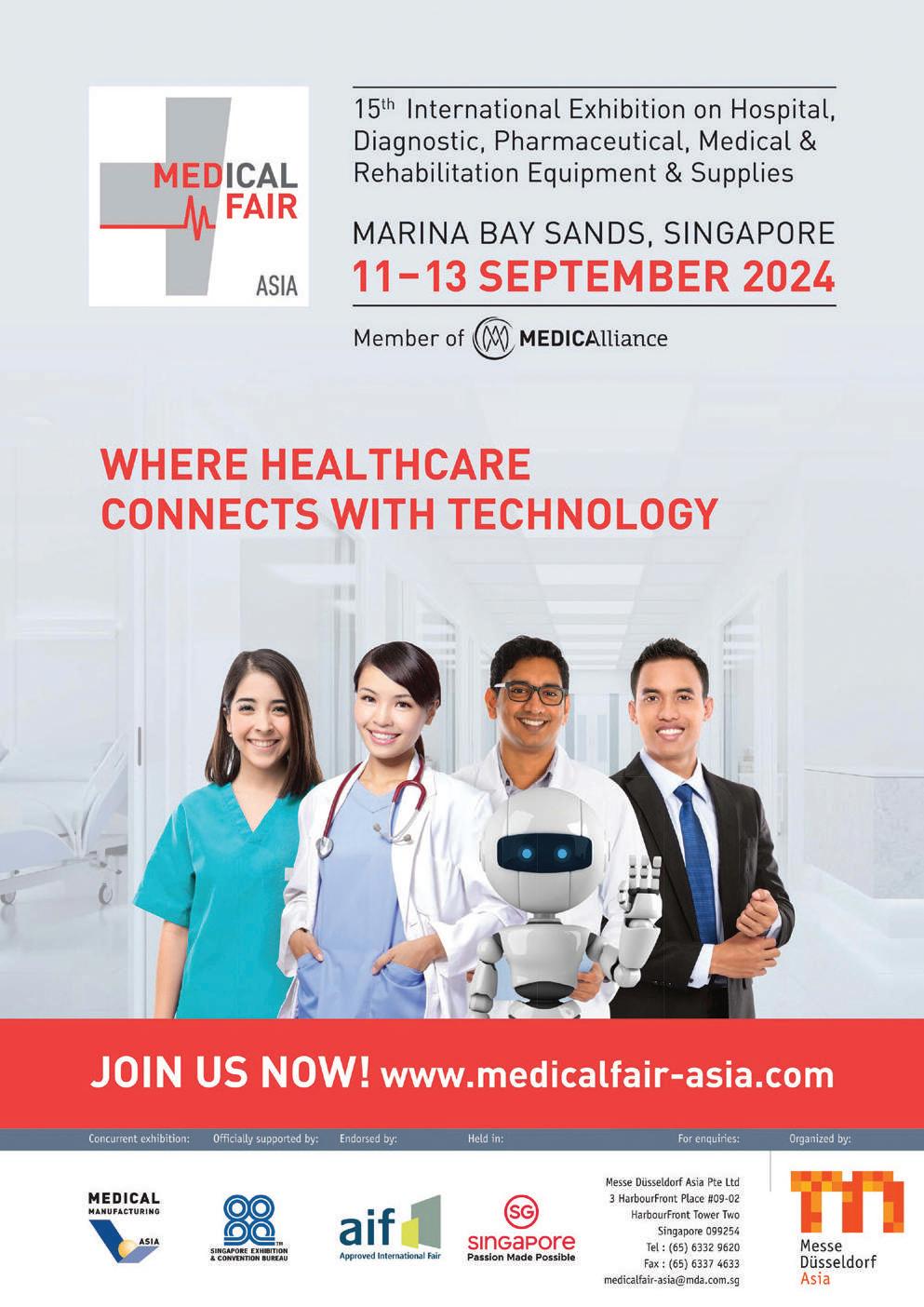

Consistent evidence shows that higher exposure to ultra-processed foods is associated with an increased risk of 32 damaging health outcomes including cancer, major heart and lung conditions, mental health disorders, and early death.
The findings, published 28 February by The BMJ [1], show that diets high in ultra-processed food may be harmful to many body systems and underscore the need for urgent measures that target and aim to reduce dietary exposure to these products and better understand the mechanisms linking them to poor health.
Ultra-processed foods, including packaged baked goods and snacks, fizzy drinks, sugary cereals, and ready-toeat or heat products, undergo multiple industrial processes and often contain colours, emulsifiers, flavours, and other additives. These products also tend to be high in added sugar, fat, and/or salt, but are low in vitamins and fibre.
They can account for up to 58% of total daily energy intake in some high income countries, and have rapidly increased in many low and middle income nations in recent decades.
Many previous studies and metaanalyses have linked highly processed food to poor health, but no comprehensive review has yet provided a broad assessment of the evidence in this area.
To bridge this gap, researchers carried out an umbrella review (a high-level evidence summary) of 45 distinct pooled meta-analyses from 14 review articles associating ultra-processed foods with adverse health outcomes.
The review articles were all published in the past three years and involved almost 10 million participants. None were funded by compa-
nies involved in the production of ultraprocessed foods.
Estimates of exposure to ultra-processed foods were obtained from a combination of food frequency questionnaires, 24-hour dietary recalls, and dietary history and were measured as higher versus lower consumption, additional servings per day, or a 10% increment.
The researchers graded the evidence as convincing, highly suggestive, suggestive, weak, or no evidence. They also assessed the quality of evidence as high, moderate, low, or very low.
Overall, the results show that higher exposure to ultra-processed foods was consistently associated with an increased risk of 32 adverse health outcomes.
Convincing evidence showed that higher ultra-processed food intake was associated with around a 50% increased risk of cardiovascular disease related death, a 48-53% higher risk of anxiety and common mental disorders, and a 12% greater risk of type 2 diabetes.
Highly suggestive evidence also indicated that higher ultra-processed food intake was associated with a 21% greater risk of death from any cause, a 40-66% increased risk of heart disease related death, obesity, type 2 diabetes, and sleep problems, and a 22% increased risk of depression.
Evidence for the associations of ultraprocessed food exposure with asthma, gastrointestinal health, some cancers and cardiometabolic risk factors, such as high blood fats and low levels of ‘good’ cholesterol, remains limited.
The researchers acknowledge that umbrella reviews can only provide high-level overviews and they can’t rule out the possibility that other unmeasured factors and variations in assessing ultra-processed food intake may have influenced their results.
However, their use of rigorous and pre-
specified systematic methods to evaluate the credibility and quality of the analyses suggests that the results withstand scrutiny.
As such, they conclude: “These findings support urgent mechanistic research and public health actions that seek to target and minimise ultra-processed food consumption for improved population health.”
Ultra-processed foods damage health and shorten life, say researchers in a linked editorial [2]. So what can be done to control and reduce their production and consumption, which is rising worldwide?
They point out that reformulation does not eliminate harm, and profitability discourages manufacturers from switching to make nutritious foods, so public policies and action on ultra-processed foods are essential.
These include front-of-pack labels, restricting advertising and prohibiting sales in or near schools and hospitals, and fiscal and other measures that make unprocessed or minimally processed foods and freshly prepared meals as accessible and available as, and cheaper than, ultra-processed foods.
It is now time for United Nations agencies, with member states, to develop and implement a framework convention on ultra-processed foods similar to the framework on tobacco, and promote examples of best practice, they write.
They say multidisciplinary investigations “are needed to identify the most effective ways to control and reduce ultra-processing and to quantify and track the cost-benefits and other effects of all such policies and actions on human health and welfare, society, culture, employment, and the environment.”
Reference:
1. doi: https://doi.org/10.1136/bmj-2023-077310
2. doi: https://doi.org/10.1136/bmj.q439

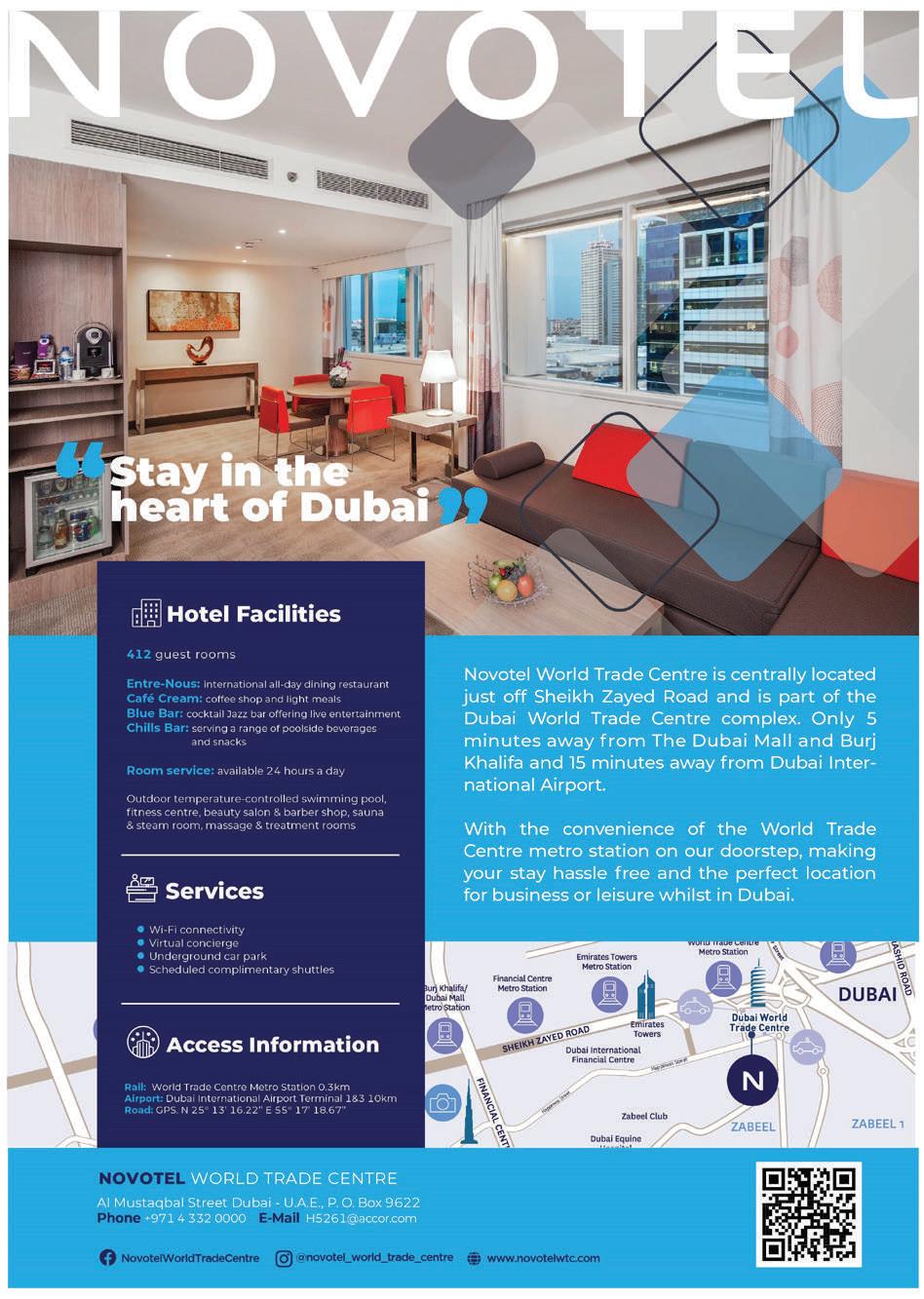
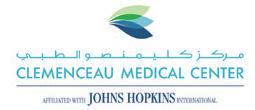
Clemenceau Medical Center (CMC), in affiliation with Johns Hopkins Medicine International, stands as a state-of-theart medical institution at the epicenter of Beirut, providing quality healthcare services to patients in Lebanon and the Middle East. The vision of CMC is to enrich the quality of life and strengthen healthcare within the local and regional community, guided by international ethics and core values such as excellence, commitment, integrity, and collegiality.
This unique private medical centre seamlessly combines luxury and technology in a 5-star setting, serving as a hub for continuous medical education, knowledge transfer, and a healing environment. Equipped with avant-garde medical technologies, CMC ensures its patients benefit from innovative treatments, making it the first of its kind in the surrounding region.
CMC’s affiliation with Johns Hopkins Medicine and multiple accreditations by the Joint Commission International (JCI) enables the centre to offer superior healthcare services within a culture of excellence and a commitment to highquality patient care.
The centre houses all specialty branches, diagnostic services, and outpatient clinics, featuring a film-less digital medical imaging environment and modern Operating Theatres with advanced laparoscopy and OR automation systems.
CMC has been a pioneer in introducing robotic surgery and cutting-edge technology in Radiation Oncology in the Middle East. The centre has achieved remarkable success rates in surgical and robotic procedures, particularly in the field of interventional medicine. Currently, under development is the kidney transplant programme

as experts in the field join the initiative.
The launch of Next Generation Sequencing (NGS) stands as a groundbreaking addition to CMC’s advanced healthcare services. NGS, a technology dedicated to genetic material sequencing, distinguishes itself through precision and rapid analysis of DNA. It offers results within 14 days, eliminating the need for overseas processing that traditionally takes over 45 days. The introduction of this technology at CMC aims to enhance disease diagnosis, improve the prediction of genetic risks, and tailor treatment plans, especially for conditions like cancer. This technology assists in formulating personalized treatment plans for patients, reinforcing CMC’s commitment to delivering effective and individualized care.
Moreover, Clemenceau Medical Center is recognized for its state-of-the-art automated laboratory system, integrating cutting-edge technologies to ensure precision, quality, and reliable results across all tests. In a recent development, the implementation of the RLDatix system has been launched, marking a new frontier in patient safety management and risk administration. This system is a cutting-edge platform dedicated to elevating patient safety through advanced incident reporting, risk management, and quality improvement modules.
The centre continuously invests in updating medical equipment and adopting the latest medical technologies, effectively contributing to improving the quality of healthcare services provided. Recently, all radiological diagnostic devices and equipment have been updated to provide accurate and effective diagnoses for patients, utilizing artificial intelligence techniques and advanced software not available in any other medical centre in Lebanon and the region.

Now, proudly announcing its 6th consecutive JCI accreditation, Clemenceau Medical Center celebrates this noteworthy achievement. It serves as a testament to CMC’s dedication to quality healthcare and its ongoing commitment to delivering exceptional services. The centre’s adherence to International Patient Safety Goals and standards since its first accreditation underscores its continuous commitment to patient safety.
In summary, Clemenceau Medical Center’s 6th consecutive JCI accreditation reflects its dedication to excellence, patient safety, and meeting global healthcare standards. CMC’s ongoing innovation, partnerships with respected institutions, and international recognition establish it as a leader in providing high-quality healthcare services worldwide.




Join us at Medical Taiwan 2024, the premier platform for showcasing groundbreaking healthcare products and technologies.
Organized by the Taiwan External Trade Development Council (TAITRA), this prestigious event will unfold from June 20 to 22, 2024, at the Taipei Nangang Exhibition Center Hall 2.
Medical Taiwan 2024 is poised to spotlight three transformative themes that are redefining the healthcare landscape: “All Age Healthcare,” “Smart Medical,” and “Supply Chain Gallery.” Through a holistic integration of medical advancements, healthcare solutions, and technological innovations, the event aims to establish a comprehensive healthcare ecosystem, unparalleled on the global stage.
All Age Healthcare: This theme underscores a commitment to catering to health needs from birth to centenarians, showcasing products that span fitness and exercise equipment, health supplements, and aids for various life stages. It’s a testament to the event’s dedication to promoting lifelong wellness and preventive care.
Smart Medical: Highlighting the revolution of digitized medical products and services, Smart Medical emphasizes technology’s role in making healthcare more precise, personalized, and accessible. Expect to see the latest in wearable tech, telehealth solutions, and AI-driven diagnostics.
Supply Chain Gallery: This gallery will exhibit the breadth and depth of the supply chain, from raw materials to finished products. It aims to illuminate the interconnectedness of the industry and foster partnerships that enhance innovation and efficiency.
Reflecting on the success of 2023, Medical Taiwan attracted over 7,000 visitors, including 10% of C-Level


executives, marking a 22% increase in attendance from 2019. This growth not only highlights the event’s significant role in business matchmaking and industry trendsetting but also underscores its resilience and expanding influence in a post-pandemic world.
As global demographics shift towards an aging population, the healthcare industry is at the forefront of addressing the ensuing challenges and opportunities. With major corporations like Google, Apple, and Amazon entering the healthcare space, the industry is ripe for innovation. Taiwan, on the cusp of becoming a super-aging society by 2025, is already demonstrating its capability to lead in medical technology and healthcare systems, deeply intertwined with the global technology supply chain.
Taiwan: The Hub of Medical Excellence
Taiwan’s prominence as a hub of medical excellence and its integration into the global technology supply chain paves the way for the exponential growth of smart healthcare solutions and caregiving. Medical Taiwan 2024 embodies this

TAITRA is a non-profit organization established by the Taiwanese government in 1970. Its objective is to promote Taiwan’s foreign trade and facilitate business collaborations. TAITRA operates through a network of 5 local offices as well as over 60 offices worldwide, providing trade promotion, market research, education, and matchmaking services. TAITRA plays a crucial role in enhancing Taiwan’s global trade presence and promoting economic development.
synergy, creating a platform for stakeholder interaction, collaboration, and forwardlooking solutions.
Join the Revolution at Medical Taiwan 2024
Don’t miss this exceptional opportunity to be at the forefront of medical innovation, where cutting-edge solutions meet global commercial opportunities. Medical Taiwan 2024 is not just an event; it’s a gateway to the future of healthcare, unfolding new possibilities and connections.
• For more information and to apply for a booth, visit our official website at: https://www.medicaltaiwan.com.tw/en/index.html and access our application kit at: https://www.medicaltaiwan.com.tw/en/menu/DA10C1E913B393ADD0636733C6861689/info.html

A new University of Kentucky Markey Cancer Center study published in JCO Precision Oncology[1] demonstrates a feasible way to expand germline genetic testing for patients with cancer.
Germline testing analyzes an individual’s DNA to identify inherited genetic mutations that increase the risk for cancer and other diseases. For patients with cancer, the tests can determine potential therapies and identify family members that would benefit from risk reduction strategies and early screening opportunities.
Current guidelines recommend germline testing for patients with certain cancers including ovarian, pancreatic, and metastatic prostate cancer. While patients with other types of cancer may
also receive germline testing as part of research initiatives, those test results are not routinely reported.
The study led by UK Markey Cancer Center researcher Jill Kolesar, Pharm.D., aimed to bridge this gap by sharing researchbased germline test findings with oncologists.
In the study, Markey Cancer Center’s Molecular Tumor Board (MTB) reviewed germline research test results from a group of patients with various cancers. Findings were then communicated to patients’ oncologists, along with recommendations for genetic counselling and confirmatory testing.
Among 781 participants, more than 4% had genetic mutations related to inherited
cancers. More than a third of those cases would have been missed by the existing guidelines. The team also identified 14 patients at risk for other hereditary diseases not typically covered by standard germline testing for cancer risk.
“These findings not only demonstrate the feasibility of expanded germline testing but also its potential to bring lifesaving benefits to even more patients and improve personalized cancer care,” said Kolesar, a professor in UK’s College of Pharmacy who directs Markey’s Precision Medicine Clinic and co-directs the MTB.
The study’s findings also suggest a role in expanding germline testing for patients with other cancers including endometrial, lung and head or neck cancer.
Reference:
1.Hutchcraft M., Zhang S., Pickarski J., et. al. Feasibility and Clinical Utility of Reporting Hereditary Cancer Predisposition Pathogenic Variants Identified in Research Germline Sequencing: A Prospective Interventional Study. JCO Precision Oncology. Vol 8, Number 8. Jan 31, 2024. doi: https://doi.org/10.1200/PO.23.00266
Using RNA sequencing and spatial transcriptomics, scientists at Pusan National University, Korea, discovered the roles of PKM gene and EPHA2 pathway in the development of HNSCC. Middle East Health reports.
Head and neck squamous cell carcinoma (HNSCC) is a type of cancer that affects the mucous membranes of the mouth, nose, and throat. HNSCC is typically associated with tobacco exposure, alcohol abuse, and viral infections. The links between human papillomavirus (HPV) infection status and the molecular characteristics of HNSCC are not clearly defined.
In a novel and pioneering research work, a team of scientists led by Yun Hak Kim, Assistant Professor in the Department of Anatomy and Department of Biomedical Informatics at the
School of Medicine at Pusan National University, Korea, has recently studied the cellular diversity and molecular attributes within the complex tumour microenvironment of HNSCC with respect to the status of HPV infection. Their research findings were recently published in the Journal of Medical Virology [1] .
“The incidence of HNSCC has gone up considerably in the recent years and yet very little is known about the exact molecular mechanisms regarding the role of HPV infection and its link with HNSCC,” Dr Kim commented, revealing the inspiration behind the present research work.
Using samples from both HPV negative (HPV−) and HPV positive (HPV+) patients for single-cell RNA profiling, a genetic sequencing technique, and spatial transcriptomics (ST), an advanced molecular profiling technique, the primary tumours and lymph node metastatic tumours (LNMTs) were analyzed. The in-depth research findings provide remarkable imagery into the complex links between HPV infection and the development of HNSCC.
In the case of HPV+ HNSCC, immune cells actively participated in the development of tumours. The molecular
Researchers find oncoprotein AF1q plays key role in neuroblastoma, which accounts for 15% of all paediatric cancer deaths
Researchers have newly identified a universal, essential biomarker for the childhood cancer neuroblastoma – and a potential new target for treatment.
Neuroblastoma accounts for 15% of all paediatric cancer deaths and is the most common source of childhood tumours outside of brain cancer. The disease develops in early nerve tissue, usually in and around the adrenal glands, and typically affects children under age five. High-risk cases have a five-year survival rate of just 50%.
Led by UC San Francisco, researchers suspected the oncoprotein AF1q, which is known to play a role in leukemic and solid tumour progression, might be important in tumours of neural origin too. They used
the Broad Institute’s Cancer Cell Line Encyclopedia database to compare AF1q gene expression – that is, whether and how the gene is used to make cancer proteins – in 37 different types of paediatric and adult malignancies.
The researchers also used the “Depmap” Cancer Dependency Map database to analyze the impact of gene silencing and gene editing of different cancer cell lines.
AF1q, they found, was expressed at the highest levels in neuroblastoma compared to all other tumour types. Neuroblastoma cells were also more reliant upon AF1q than any other cell line. And when they silenced AF1q in neuroblastoma cells, it appeared to initiate cell death and weaken the progress of tumours. Results
were published in Oncogene [1]
The key to how AF1q works in neuroblastoma, said Julie Saba, MD, UCSF paediatric oncologist and senior study author, appears to be its ability to maintain high cellular levels of N-myc, another oncoprotein which is linked to high-risk neuroblastoma.
“N-myc has long been considered an ‘undruggable’ target in neuroblastoma,” Dr Saba said. “But now we see AF1q as a potential Achilles heel we can use to destabilize that target.”
Future studies will focus on determining how AF1q interacts with other cellular proteins and then using that information to target AF1q’s actions in cancer cells.
Reference:
Oskouian, B., Lee, J.Y., Asgharzadeh, S. et al. AF1q is a universal marker of neuroblastoma that sustains N-Myc expression and drives tumorigenesis. Oncogene (2024). https://doi.org/10.1038/s41388-024-02980-y
characteristics of HNSCC were highly influenced by the status of HPV infection rather than the actual location of tumour. The analyses of RNA sequencing and ST indicated the crucial role of pyruvate kinase muscle (PKM) gene in the development of cancer stem cell-like populations in the LNMT of HPV− tissue. In HPV− HNSCC cell lines, the expression of PKM gene was consistent and indicated a role in the spheroid structure formation ability, which was studied using genetic knockdown of PKM2 gene. Interestingly, during the ST analysis of the HPV+ patients, the
presence of such ectopic lymphoid structure was confirmed.
Dr Kim and their team went a step further and focused their efforts to study the critical angiogenesis-new blood vessel formation pathway. They used single-cell RNA and ST profiles of HPV− patients and found that Ephrin-A (EPHA2) was mainly involved in angiogenesis and cell migration pathways.
“Our novel research findings of PKM and EPHA2 molecular pathways can be utilized as therapeutic targets in suppressing the growth and spread of HNSCC cancer cells. Also, the tumour microenvironment is affected by the status of HPV infection
and thus, precision medicine can be developed against HNSCC,” concludes Dr Kim, underlining the potential real-life applications of the research work.
Overall, this study significantly enhances our understanding of HNSCC microenvironment. Thus, it can guide new approaches to HNSCC treatment, especially in inhibiting cancer cell growth and migration. Therefore, the HPV infection could be considered a criterion for developing treatment strategies, thereby enabling precision medicine tailored to the patient’s condition.
Reference:
Lee H., Park S., Yun JH., et. al. Deciphering Head and Neck Cancer Microenvironment: Single‐Cell and Spatial Transcriptomics Reveals Human Papillomavirus‐Associated Differences. Journal of Medical Virology. 18 January 2024.
doi: https://doi.org/10.1002/jmv.29386
Physicians treating patients with earlystage lung cancer face a conundrum: choosing potentially helpful yet toxic therapies such as chemotherapy, radiation or immunotherapy to knock out the cancer and lessen the risk of it spreading to the brain, or waiting to see if lung surgery alone proves sufficient. When up to 70% of such patients do not experience brain metastasis – the spread of cancer to the brain – the question arises: Who should receive additional aggressive treatments, and who can safely wait?
A new study led by Washington University School of Medicine in St. Louis could help physicians strike the right balance between proactive intervention and cautious monitoring for patients with early-stage lung cancer. The study, published March 4 in The Journal of Pathology [1], uses an artificial intelligence (AI) method to study patients’ lung biopsy images and predict whether the cancer will spread to the brain.
“There are no predictive tools available to help physicians when treating patients with lung cancer,” said Richard J. Cote, MD, the Edward Mallinckrodt Professor and head of the Department of Pathology & Immunology. “We have risk predictors that tell us which population is more likely to progress to more advanced stages, but we lack the ability to predict individual patient outcomes. Our study is an indication that AI methods may be able to make meaningful predictions that are specific and sensitive enough to impact patient management.”
Lung cancer is the leading cause of cancer death worldwide. Most lung cancers are characterized as non-small cell lung cancers, which are largely, but not exclusively, caused by smoking. For early-stage cancer patients, tumours are confined to the lung, and surgery is recommended as a first line of treatment. Roughly 30% of such patients progress to advanced stages, when the cancer spreads to the lymph nodes and other organs. With the brain
often affected first, such patients require additional treatments, including chemotherapy, targeted drug therapy, radiation therapy and/or immunotherapy. However, physicians have no way of knowing whose cancer will progress, so they frequently treat patients with aggressive therapies out of caution.
Dr Cote worked with Ramaswamy Govindan, MD, the Anheuser Busch Endowed Chair in Medical Oncology and associate director of the oncology division at Washington University; Mark Watson, MD, PhD, the Margaret Gladys Smith Professor in the Department of Pathology & Immunology; and Changhuei Yang, PhD, a professor of electrical engineering, bioengineering, and medical engineering at the California Institute of Technology, to determine if AI could predict whether cancer will spread to the brain.
In diagnostic testing, a pathologist examines biopsied tissues under a microscope to identify cellular abnormalities that may hint at disease. Advanced technologies –such as AI – are being explored to replicate what a pathologist sees when making diagnoses but with greater accuracy, Dr Cote explained.
A key question: Can AI detect abnormal features that a pathologist cannot?
AI accurate in predicting which patients won’t develop metastasis
The researchers trained a machine-learning algorithm to predict brain metastasis using 118 lung biopsy samples from earlystage non-small cell lung cancer patients. Some of the patients developed brain cancer during a five-year monitoring period, and some did not and were in remission. Then the researchers tested the AI method on its ability to predict brain metastasis, and to identify patients who develop no metastasis, using 40 other patients’ lung biopsy samples.
The algorithm was able to predict the eventual development of brain cancer with
87% accuracy. In comparison, four pathologists who participated in the study were an average of 57.3% accurate. Importantly, the algorithm was highly accurate in predicting which patients would not develop brain metastasis.
“Our results need to be validated in a larger study, but we think there is great potential for AI to make accurate predictions and impact care decisions,” said Dr Govindan, who treats lung cancer patients at Siteman Cancer Center, based at Barnes-Jewish Hospital and Washington University School of Medicine. “Systemic treatments such as chemotherapy, while effective in killing cancer cells, can also harm healthy cells and are not always the preferred treatment method for all earlystage cancer patients. Identification of patients who are likely to relapse in the brain may help us develop strategies to intercept cancer early in the process of metastasis. We think AI-based predictions could, one day, inform personalized treatments.”
The AI system evaluates tumours’ and healthy cells’ features, similar to how the human brain allows us to scan facial features for quick recognition of familiar faces. However, what the algorithm sees is unknown; the scientists are working to understand the molecular and cellular features that AI uses for its predictions. This knowledge could lead to the development of novel therapeutics and influence the design of imaging instruments optimized for the collection of data for AI.
“This study started as an attempt to find predictive biomarkers,” said Yang. “But we couldn’t find any. Instead, we found that AI has the potential to make predictions about cancer progression using biopsy samples that are already being collected for diagnosis. If we can get to a prediction accuracy that will allow us to use this algorithm clinically and not have to resort to expensive biomarkers, we are talking about significant ramifications in cost-effectiveness.”
Reference:
Pathol. (2024). doi: https://doi.org/10.1002/path.6263
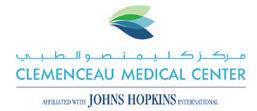
Clemenceau Medical Center, Beirut-Lebanon, in affiliation with Johns Hopkins Medicine International, is positioned as a cutting-edge medical institution centrally located in Beirut, serving as a beacon of quality healthcare for patients across Lebanon and the Middle East. CMC’s visionary mission is to enhance the quality of life and fortify healthcare standards within the local and regional community.
CMC has just acquired an upgrade for its Radiation Oncology department. This enhancement will ensure that CMC maintains its position at the forefront of stateof-the-art radiation delivery in Lebanon and the Middle East. The upgrade features a Brainlab ExacTrac Dynamic system and a Varian PerfectPitch 6 degrees of freedom couch, enabling submillimetric patient positioning and monitoring accuracy.
With this latest advancement, CMC continues to exemplify its commitment to providing cutting-edge medical services. This new technology enhances the precision and accuracy of radiation therapy, further elevating the standard of care for cancer patients.
As the first medical centre in the Middle East, with a Radiation Oncology Department certified by the Novalis certificate, CMC remains dedicated to upholding the highest quality and safety standards in radiotherapy and surgery treatments. The integration of the Brainlab ExacTrac Dynamic system and Varian PerfectPitch couch underscores CMC’s ongoing efforts to stay at the forefront of technological innovation, ensuring optimal outcomes for patients undergoing radiation therapy.
This state-of-the-art upgrade facilitates submillimetric precision in patient positioning and monitoring, setting a new benchmark for radiation oncology in the region. As CMC continues to advance its capabilities, it reaffirms its commitment to providing comprehensive and advanced care to individuals facing cancer and other related conditions.
Clemenceau Medical Center’s Cancer Center not only boasts the most advanced technology, but also offers a comprehen-
sive range of services to ensure the best possible care for patients:
Comprehensive Diagnostic and Interventional Radiology Department:
• Ultrasound
• CT with 83% less radiation
• 3Tesla Silent MRI
• PET/CT
• Ductogram
• Digital Mammography with 3D Tomosynthesis
Interventional Radiology
Laboratory & Pathology Support:
Ensuring accurate and timely diagnostic services.
Surgical Oncology:
Utilizing minimally invasive da Vinci robotic surgical systems for advanced and precise procedures.
Medical Oncology:
Providing comprehensive medical oncology services tailored to individual patient needs.
Radiation Therapy: Offering state-of-the-art radiation therapy for targeted and effective cancer treatment.
Supportive Services: Including pain management and palliative care to enhance patient comfort and quality of life.
Continuous Education and Research:
Affiliated with Johns Hopkins Medicine International, ensuring ongoing education and research initiatives.
Internal Pharmacy:
Providing access to the latest and most effective drugs for comprehensive patient care. This integrated and multidisciplinary approach at CMC Cancer Center emphasizes not only cutting-edge technology, but also a commitment to patient-centred care, education, and research, ensuring the highest standards of excellence in cancer treatment and support.


To ensure Caring, Safety, and Excellence, a multidisciplinary team, including organ specialists (medical/surgical), medical oncologists, radiation therapists, rehabilitation therapists, and psychologists, will be available throughout the entire patient journey. This collaborative approach emphasizes a comprehensive and holistic care strategy, addressing medical, emotional, and rehabilitative aspects to enhance the well-being of individuals undergoing treatment. The continuous presence of this multidisciplinary team underscores CMC’s commitment to providing personalized and integrated care, supporting patients at every stage of their medical experience.


Under the theme of ‘Connecting Minds, Transforming Healthcare’, the Arab Health Exhibition and Congress 2024, the largest gathering of healthcare professionals and businesses in the MENA region, took place at the Dubai World Trade Centre from 29 January to 1 February.
The 2024 edition of the show was the largest in the show’s 49year history, in terms of exhibition space, filling every hall of the Dubai World Trade Centre with 3,450 exhibitors and 110,000 professional visitors representing 180 countries.
Some 330 expert speakers delivered presentations during more than 165 sessions at the Arab Health Congress, which featured 10 Continuing Medical Education conferences.
Arab Health 2024 was supported by various government entities, including the UAE Ministry of Health and Prevention, the Government of Dubai, the Dubai Health Authority, the Department of Health, and the Dubai Healthcare City Authority.
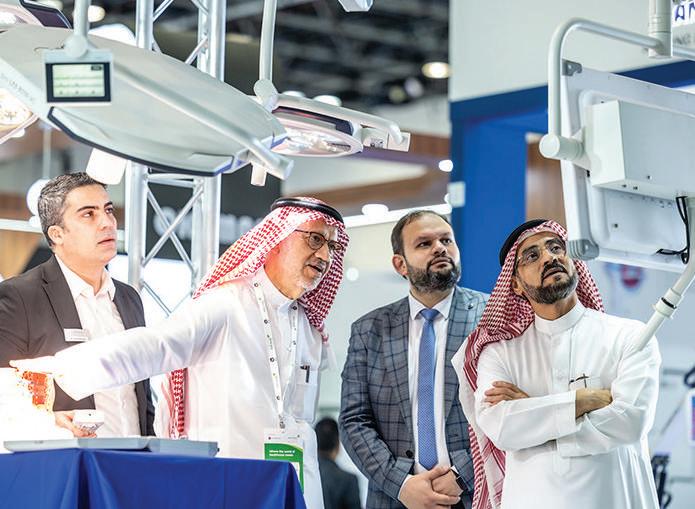
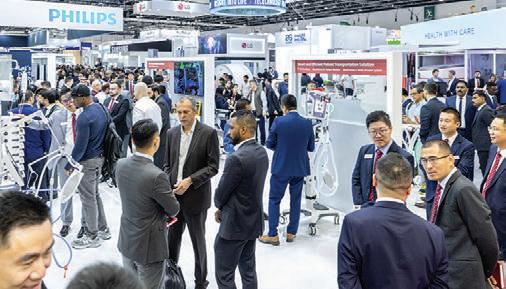
Dubai Health, the first integrated academic health system in Dubai, held an industry briefing session on Day 1 of the Arab Health Exhibition and Congress.
Dr Amer Sharif, CEO of Dubai Health, presented a comprehensive overview of Dubai’s first integrated academic health system model to more than 150 industry thought leaders and officials from the UAE and abroad. Drawing parallels with globally renowned institutions adopting similar models, Dr Amer shared exclusive insights on the work being undertaken by Dubai Health.
Dr Amer highlighted Dubai Health’s commitment to enhancing health outcomes by developing local talent and fostering research and innovation. He also shed light on working collaboratively by integrating knowledge, people, and capabilities to deliver patient-centric, evidence-based care that sets new benchmarks in healthcare excellence.
“Through a unified commitment to patientcentred care, we are not just shaping the present healthcare landscape, but also laying the foundation for a transformative future anchored in our primary value of ‘Patient First’. This commitment extends beyond the present, as we strive to create a lasting impact on the lives and wellbeing of our community for generations to come,” Dr Amer said.
“Central to our goals are partnerships and collaborations that amplify our efforts and catalyze innovation. By cultivating strong alliances with stakeholders across the healthcare spectrum, we harness collective expertise and resources to address the present health challenges and drive meaningful change, ensuring that together we advance health for humanity.”
Dubai Health was established to elevate the standard of care and to advance health for humanity. Dubai Health comprises six hospitals, 26 ambulatory health centres, 20 medical fitness centres, Mohammed Bin Rashid Uni-
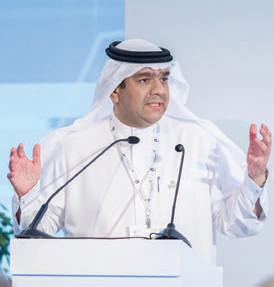
versity of Medicine and Health Sciences, and Al Jalila Foundation through the integration of care, learning, discovery, and giving. Eleven thousand employees collaborate across multidisciplinary teams to put the patient first.

Philips showcased a host of next-generation innovations and solutions at Arab Health 2024 to help hospitals and health systems to deliver high-quality care to patients in a sustainable way, enabled by emerging technology that improves predictability, collaboration, precision and integration.
The new innovations included nextgeneration ultrasound systems that increase diagnostic confidence and workflow efficiency, workflow optimization through AI-powered innovations in MR (SmartSpeed [1]), and new AI-enabled cloud solutions that enhance healthcare efficiency and clinical confidence. Philips also exhibited their next-generation Image Guided Therapy System designed to perform a wide range of routine and complex interventional procedures.
Philips highlighted interoperability of Philips MDIP (Medical Device Information Platform) Integration [2] with Philips Patient Information Center iX (PIC iX) [3], providing hospitals with a first-of-its-kind, comprehensive patient overview. Interoperability between MDIP and PIC iX enables the capture of streaming data flowing freely from a variety of medical device manufacturers on an open, scalable, secure platform.
By disseminating this information, clinicians have a unified view of the patient that delivers enhanced clinical insights and actionable alerts to help caregivers make treatment recommendations confidently.
Also on display was Philips’ Visual Patient Avatar [4]; a revolutionary new monitoring solution that translates complex patient data into a straightforward, easy-to-understand visual display. Visual Patient Avatar is a clinical decision support tool designed in partnership with anaesthesiologists to help improve situational awareness in


critical care environments. A simplified monitor view of the patient’s body and vital signs helps care providers to recall and process critical data more efficiently and confidently.
Philips also featured its PageWriter TC35 Cardiograph [5], a compact solution that provides advanced tools to enhance workflow, facilitate quality ECG reports, and support clinical decisions. The seamless design of the new compact lead-set means fewer connections for staff to manage.
With a growing need for more efficient healthcare solutions that prioritize patients, healthcare professionals and the planet, Philips’ MRI portfolio remains leading-edge.
The MR 5300 [6] is the industry’s first and still the only fully-sealed 1.5T magnet to be introduced in a commercially available MRI scanner, designed for sustainable imaging at lower site costs without image quality or clinical compromises. In addition, a variety of time saving features are included across Philips’ entire portfolio including AIdriven technologies in the MR5300 with BlueSeal Magnet, automating the most complex clinical and operational tasks, resulting in patient set-up in under a minute and the reduction of change-over time between exams by up to 30%.
Philips showcased its next-generation portable ultrasound solution for the META region – the Compact 5000 Series [7] – to facilitate first-time-right ultrasound exams for more patients.
The portability of the Ultrasound Compact 5000 Series brings quality ultrasound to the patient wherever they are in the hospital, with advanced features not typically found on a portable system, including AI-powered automation tools. Designed for shared service capabilities across specialties including cardiovascular, obstetrics and gynaecology, point of care, and general imaging, the Compact Ultrasound 5000 series system helps meet the needs of multiple clinical segments.
Other solutions on show at Arab Health included the Image Guided Therapy System –Azurion 7 B20/15 [8] that allows clinicians to perform a wide range of routine and complex interventional procedures easily and confidently while optimizing lab performance for patient care.
The Spectral CT 7500 [9] offers a low-dose path to precision diagnosis for a wide range of patients with both conventional
and 100% spectral results with every scan, which have demonstrated 34% shorter time to diagnosis with detector-based CT.
In addition, Philips also spotlighted the IntelliSite Pathology Solution [10] which delivers diagnostic-quality slide images to pathologists and clinicians wherever they are, uniting care teams and curating data. With all images stored digitally, the solution also allows third-party
References:
1. https://www.philips.ae/healthcare/resources/landing/smartspeed
2. https://www.usa.philips.com/healthcare/e/capsule-medical-device-integration-platform
3. https://www.usa.philips.com/healthcare/product/HCNOCTN171/patient-information-center-ix-pic-ix
4. https://www.philips.com/visual-patient-avatar
5. https://www.usa.philips.com/healthcare/product/860437/pagewriter-tc35-cardiograph
6. https://www.philips.ae/healthcare/resources/landing/mr-5300
7. https://www.usa.philips.com/healthcare/solutions/ultrasound
integration of AI applications, and together with PACS it can be used to streamline workflow for improved efficiency, for example by rapidly identifying pathology images that need urgent attention.
8. https://www.philips.ae/healthcare/product/HCNCVD016/azurion-7-b2015-biplane-image-guided-therapy-system
9. https://www.philips.ae/healthcare/resources/landing/spectral-ct-7500
10. https://www.philips.ae/healthcare/solutions/pathology/pathology/intellisite-pathology-solution
Dubai Healthcare City Authority (DHCA), the governing body of Dubai Healthcare City (DHCC) free zone, unveiled a report titled “Dubai’s Healthcare Ecosystem Highlights” at Arab Health 2024, which provides key insights and strong growth indicators in the emirate’s healthcare sector. The new report sheds light on Dubai Healthcare City’s (DHCC) commitment to advancing the healthcare ecosystem, and its approach to seamlessly integrating core healthcare services and collaborating with global organisations.
Key findings from the report highlight the important role DHCC plays as the emirate’s healthcare investment hub, with the free zone’s turnover between 2020 and 2024 expected to increase significantly at an estimated 16% Compound Annual Growth Rate (CAGR). The figure underscores the free zone’s commitment to its ecosystem’s efficiency and sustainability, and confidence from major regional and international healthcare investors in DHCC’s capability to enable growth opportunities in Dubai’s dynamic healthcare landscape.
Other key findings reaffirm the robust growth of Dubai’s healthcare industry, showing strong increases in both public and private sector UAE healthcare expenditure. Public sector spending is set to reach AED104 billion (US$28 billion) by 2027.
The study also highlights DHCC’s ongo-

ing expansion of Phase 2, which is designed to complement the healthcare ecosystem with preventive care, wellness and urban lifestyle. Encompassing approximately 22 million square feet, Phase 2 has attracted strategic investment of AED1.03 billion from 2019 to date. The allocation includes 57.65% for mixed use commercial and residential, 18.88% for hospitality and residential, 10.73% for healthcare, 10.11% for commercial and hospitality and 2.63% for residential. The development of Phase 2 aligns with DHCC’s commitment to attract more investors, expanding healthcare and residential facilities to address the evolving needs of Dubai’s growing population.
Aligning with the emirate’s vision for a dynamic healthcare industry to serve a projected population of 5.8 million by 2040 and the Dubai 2040 Urban Master Plan, which has a goal to increase the land area for education and health facilities by 25%, DHCC plays a key role in attracting investment to contribute to these ambitious goals, fostering a vibrant, healthy and inclusive
community for residents and visitors.
Allae Almanini, Chief Financial Officer, Dubai Healthcare City Authority, said: “We are constantly striving to ensure collaborations to extend healthcare services and attract investments that directly contribute to achieving the goals of the Dubai 2040 Urban Master Plan. Our commitment extends to developing strategic partnerships, establishing community health clinics and pioneering innovative co-living concepts. As the healthcare landscape continues to evolve, we remain at the forefront, exemplifying unparalleled growth and dedication to creating a holistic healthcare and wellness ecosystem.”
DHCC’s ecosystem offers a wide range of medical services with 481 registered facilities, including advanced diagnostic procedures, specialised treatments and surgical procedures. With 195 clinical facilities and 130 regional headquarters of global companies, DHCC continues to lead the transformation of Dubai’s healthcare landscape, providing direct access to an unrivalled network of partners.

SCHILLER is very pleased to introduce the FRED easy G2, the new automated external defibrillator. The FRED easy G2 is CE certified in accordance with MDR. The device is already in production.
A flexible AED, robust and intuitive
SCHILLER’s FRED easy G2 defibrillator is designed for basic and advanced life support. It guides the rescuer through all the intervention. Compact, lightweight, smart and ready for action, the device perfectly complements every emergency kit, offering mobility and flexibility in a time-critical situation.
The device is available in semi-automatic and automatic mode. The semi-automatic mode provides flexibility for professional user in time critical situations. The fully automatic mode allows the layperson to be confident while performing the resuscitation and delivers a shock automatically, if required. Both versions assist in performing cardiopulmonary resuscitation. The FRED easy G2 is intuitive to use with its userfriendly 5” LCD touch screen and a 1-2-3 workflow to follow. The interface displays clear, coloured graphics combined with audio and text prompts that guide the rescuer through the entire intervention.
Key features at a glance
• 5” touch screen
• Always ready: green flashing LED and regular self-tests
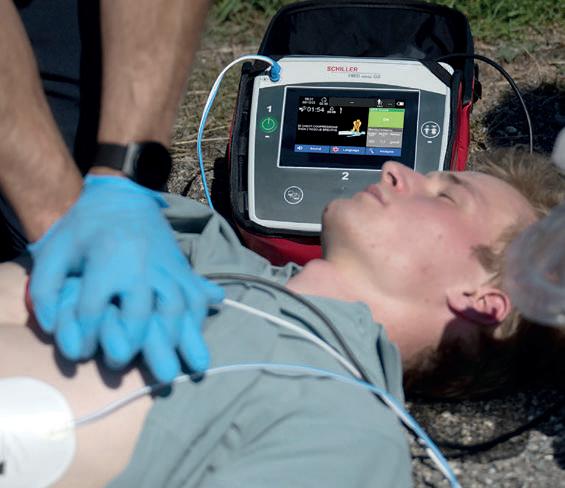
• Smart defibrillation pads: the device gives an alert on the expiration date of the defibrillation pads
• CPR assistance: metronome, FreeCPR (option) and ARGUS LifePoint sensor (option)
• Integrated paediatric mode: same electrodes for adult and paediatric
• Choose among four predefined languages (option)
• USB, Bluetooth, cellular network (option) and Wi-Fi
• LifeDataNet G2 (option): Visualise AEDs on map, check status, perform software updates remotely, etc.
• Robust: IP55, the device is resistant against water splashes
• Operating temperature range: 0°C to 50°C, Transport/storage: -20°C to 70°C
Discover more about the FRED easy G2 on the SCHILLER website, such as the detailed product description in video and brochure format: www.schiller.ch
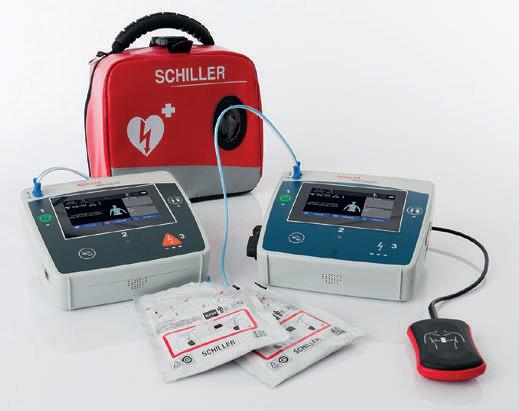

MIT engineers have developed a small ultrasound sticker that can monitor the stiffness of organs deep inside the body. The sticker, about the size of a postage stamp, can be worn on the skin and is designed to pick up on signs of disease, such as liver and kidney failure and the progression of solid tumours.
In an open-access study that appears in Science Advances [1], the team reports that the sensor can send sound waves through the skin and into the body, where the waves reflect off internal organs and back out to the sticker. The pattern of the reflected waves can be read as a signature of organ rigidity, which the sticker can measure and track.
“When some organs undergo disease, they can stiffen over time,” says the senior author of the paper, Xuanhe Zhao, professor of mechanical engineering at MIT. “With this wearable sticker, we can continuously monitor changes in rigidity over long periods of time, which is crucially important for early diagnosis of internal organ failure.”
The team has demonstrated that the sticker can continuously monitor the stiffness of organs over 48 hours and detect subtle changes that could signal the progression of disease. In preliminary experiments, the researchers found that the sticky sensor can detect early signs of acute liver failure in rats.
The engineers are working to adapt the design for use in humans. They envision that the sticker could be used in intensive care units (ICUs), where the low-profile sensors could continuously monitor patients who are recovering from organ transplants.
“We imagine that, just after a liver or kidney transplant, we could adhere this sticker to a patient and observe how the rigidity of the organ changes over days,” lead
author Hsiao-Chuan Liu says. “If there is any early diagnosis of acute liver failure, doctors can immediately take action instead of waiting until the condition becomes severe.” Liu was a visiting scientist at MIT at the time of the study and is currently an assistant professor at the University of Southern California.
The study’s MIT co-authors include Xiaoyu Chen and Chonghe Wang, along with collaborators at USC.
Like our muscles, the tissues and organs in our body stiffen as we age. With certain diseases, stiffening organs can become more pronounced, signalling a potentially precipitous health decline. Clinicians currently have ways to measure the stiffness of organs such as the kidneys and liver using ultrasound elastography – a technique similar to ultrasound imaging, in which a technician manipulates a handheld probe or wand over the skin. The probe sends sound waves through the body, which cause internal organs to vibrate slightly and send waves out in return. The probe senses an organ’s induced vibrations, and the pattern of the vibrations can be translated into how wobbly or stiff the organ must be.
Ultrasound elastography is typically used in the ICU to monitor patients who have recently undergone an organ transplant. Technicians periodically check in on a patient shortly after surgery to quickly probe the new organ and look for signs of stiffening and potential acute failure or rejection.
“After organ transplantation, the first 72 hours is most crucial in the ICU,” says another senior author, Qifa Zhou, a professor at USC. “With traditional ultrasound, you need to hold a probe to the body. But you can’t do this continuously over the long term. Doctors might miss a

crucial moment and realize too late that the organ is failing.”
The team realized that they might be able to provide a more continuous, wearable alternative. Their solution expands on an ultrasound sticker they previously developed to image deep tissues and organs.
“Our imaging sticker picked up on longitudinal waves, whereas this time we wanted to pick up shear waves, which will tell you the rigidity of the organ,” Zhao explains.
Existing ultrasound elastrography probes measure shear waves, or an organ’s vibration in response to sonic impulses. The faster a shear wave travels in the organ, the stiffer the organ is interpreted to be. (Think of the bounce-back of a water balloon compared to a soccer ball.)
The team looked to miniaturize ultrasound elastography to fit on a stampsized sticker. They also aimed to retain the same sensitivity of commercial handheld probes, which typically incorporate about 128 piezoelectric transducers, each of which transforms an incoming electric field into outgoing sound waves.
“We used advanced fabrication techniques to cut small transducers from high-quality piezoelectric materials that allowed us to design miniaturized ultrasound stickers,” Zhou says.
The researchers precisely fabricated 128 miniature transducers that they incorporated onto a 25-millimeter-square chip. They lined the chip’s underside with an adhesive made from hydrogel – a sticky and stretchy material that is a mixture of water and polymer, which allows sound waves to travel into and out of the device almost without loss.
In preliminary experiments, the team tested the stiffness-sensing sticker in rats.
They found that the stickers were able to take continuous measurements of liver stiffness over 48 hours. From the sticker’s collected data, the researchers observed clear and early signs of acute liver failure, which they later confirmed with tissue samples.
“Once liver goes into failure, the organ will increase in rigidity by multiple times,” Liu notes.
“You can go from a healthy liver as wobbly as a soft-boiled egg, to a diseased liver that is more like a hard-boiled egg,” Zhao adds. “And this sticker can pick up on those differences deep inside the body
1. Hsiao-Chuan
and provide an alert when organ failure occurs.”
The team is working with clinicians to adapt the sticker for use in patients recovering from organ transplants in the ICU. In that scenario, they don’t anticipate much change to the sticker’s current design, as it can be stuck to a patient’s skin, and any sound waves that it sends and receives can be delivered and collected by electronics that connect to the sticker, similar to electrodes and EKG machines.
The researchers are also hoping to work the sticker into a more portable,
self-enclosed version, where all its accompanying electronics and processing is miniaturized to fit into a slightly larger patch. Then, they envision that the sticker could be worn by patients at home, to continuously monitor conditions over longer periods, such as the progression of solid tumours, which are known to harden with severity.
“We believe this is a life-saving technology platform,” Zhao says. “In the future, we think that people can adhere a few stickers to their body to measure many vital signals, and image and track the health of major organs in the body.”
Reference:
Science Advances. 9 February 2024.
doi: https://doi.org/10.1126/sciadv.adk8426
Researchers show that ultrasound can be used to detect placenta problems in small babies
A Doppler ultrasound that measures the blood flow of small unborn babies can reveal whether or not the placenta is working properly. In case of repeated deviations from these Doppler measurements, additional monitoring of the unborn baby is necessary. These deviations indicate a higher risk of oxygen deficiency and other health problems for the baby. This study by Amsterdam UMC in collaboration with UMC Groningen and 17 other Dutch hospitals is published today in the British Journal of Obstetrics & Gynaecology
Around 10% of unborn babies are classed as small for their gestational age. If these babies are still healthy, there is no need for intervention during pregnancy. But in the case of small babies with a malfunctioning placenta, action must be taken and sometimes it is necessary for the baby’s birth to be induced.
“This means it is incredibly important to track down which babies are smaller due to the placenta,” says Wessel Ganzevoort, associate professor of obstetrics at Amsterdam UMC and leader of this study.
Doppler measurement
For almost 50 years, growth ultrasounds have been made to detect small babies,
and then to see if they follow their own growth pattern or if they begin to grow slower and slower. In this study, small babies also underwent a ‘Doppler ultrasound’ in addition to the standard growth measurement. This ultrasound measures the resistance of the blood vessels in the umbilical cord, which says something about the blood flow to the placenta. The ultrasound can also measure the blood supply to the child’s brain. If the supply is higher than usual, it can be a signal that the placenta is not functioning as well. The baby has then ‘opened’ the blood vessel in the brain to protect the brain against the deficiency caused by a malfunctioning placenta. With a placenta that functions less well, the risk of health problems (such as lack of oxygen) in the child and ultimately mortality around birth increases.
Part of the study was also to see if the outcomes for the child were better if the delivery was induced before a gestational age of 37 weeks. This did not lead to better outcomes. The advice is therefore to wait until at least 37 weeks of pregnancy to induce labour. This is because it is better for the baby to stay in the womb as long as possible, as long

as there are no additional risks of health problems.
“What was possible with a Doppler ultrasound was already known, but it is not yet standard practice in all hospitals. This research now shows that this measurement certainly has added value for detecting pregnancies in babies that are too small with a malfunctioning placenta,” says Mauritia Marijnen, PhD candidate at Amsterdam UMC and first author of the study.
“By adding this Doppler ultrasound to
the care plan of these undersized babies, the higher risk of problems surrounding childbirth can be better detected and
monitored. Small babies for whom the measurement is normal can also be monitored less intensively. There is therefore
a greater chance that the delivery will take place naturally, without intervention,” says Ganzevoort.
Reference:
Marijnen MC, Kamphof HD, Damhuis SE, et. al. Doppler ultrasound of umbilical and middle cerebral artery in third trimester small-for-gestational age fetuses to decide on timing of delivery for suspected fetal growth restriction: A cohort with nested RCT (DRIGITAT). BJOG. 2024; 00: 1–12. https://doi.org/10.1111/1471-0528.17770
Proceedings from an expert consensus roundtable that discussed the benefits of intravascular ultrasound (IVUS) in lower extremity revascularization procedures were released in January in the Journal of the Society for Cardiovascular Angiography & Interventions (JSCAI), Journal of Vascular and Interventional Radiology (JVIR), and Journal of Vascular SurgeryVascular Insights
The roundtable focused on the current challenges in diagnosing and treating lower extremity revascularization, knowledge and data gaps, and the potential role of IVUS in addressing these challenges. Experts shared their insights and experiences from the fields of interventional cardiology, interventional radiology, and vascular surgery.
Lower extremity revascularization is a critical procedure used to restore blood flow to the legs and feet in patients suffering from peripheral arterial disease (PAD) and deep venous pathology. It is estimated that millions of people worldwide are affected by these conditions, which can lead to severe pain, non-healing wounds, and even limb loss if left untreated. Although angiography is the dominant imaging modality in revascularization, it has inherent limitations. IVUS is a minimally invasive imaging technique that allows physicians to visualize the inside of blood vessels in real-time. It provides detailed information about the vessel wall, plaque composition, and blood flow characteristics, enabling more accurate diagnosis and treatment planning.
“Improvements in outcomes following peripheral vascular intervention have lagged compared to other endovascular treatments, such as percutaneous coronary intervention. Both clinical experience and evidence support the greater use of peripheral IVUS to reduce adverse events and extend the patency of our lower extremity revascularization procedures. By gathering experts from different specialties, we aimed to foster collaboration and exchange ideas to improve patient care for peripheral IVUS,” said Eric A. Secemsky, MD, MSc, FSCAI, lead author of the proceedings document and Director of Vascular Intervention, Beth Israel Deaconess Medical Center. “The roundtable provided a unique opportunity to identify knowledge gaps and discuss how IVUS can enhance our understanding and treatment of peripheral arterial and deep venous pathology.”
The expert consensus meeting was convened by SCAI and co-sponsored by: American Vein and Lymphatic Society (AVLS), American Venous Forum (AVF), Society of Interventional Radiology (SIR), Society for Vascular Medicine (SVM), and Society for Vascular Surgery (SVS).
During the roundtable, participants highlighted the potential of IVUS in guiding revascularization procedures, such as angioplasty and stenting, to optimize outcomes for patients. They also emphasized the need for further research and evidence to support the integration of IVUS into routine clinical practice.
“The insights gained from this roundtable will help shape future research, training and
clinical guidelines in the field of lower extremity revascularization,” Secemsky said. “By leveraging the power of IVUS, we can improve our ability to diagnose and treat patients, ultimately leading to better outcomes and quality of life.”
The roundtable concluded with a commitment to ongoing interdisciplinary collaboration and knowledge sharing among physicians.
Resources:
Secemsky EA, Aronow HE, Kwolek CJ, et al. Intravascular ultrasound use in peripheral arterial and deep venous interventions: multidisciplinary expert opinion from SCAI/AVF/AVLS/SIR/ SVM/SVS. J Soc Cardiovasc Angiogr Interv. Published online January 9, 2024.
doi: https://doi.org/10.1016/ j.jscai.2023.101205
Secemsky, EA, Aronow HD, Kwolek, CJ, et al. Intravascular ultrasound use in peripheral arterial and deep venous interventions: multidisciplinary expert opinion from SCAI/AVF/AVLS/SIR/SVM/SVS. J Vasc Interv Radiol 2024. Published online January 9, 2024.
doi: https://doi.org/10.1016/ j.jvir.2023.11.006
Secemsky, EA, Aronow HD, Kwolek, CJ, et al. Intravascular ultrasound use in peripheral arterial and deep venous interventions: multidisciplinary expert opinion from SCAI/AVF/AVLS/SIR/SVM/SVS. JVS-Vascular Insights. Published online January 9, 2024.
doi: https://doi.org/10.1016/ j.jvsvi.2023.100033

In a major innovation, an AI-based system has demonstrated it can learn, plan and carry out real-world chemistry experiments in the laboratory, potentially enabling human scientists to make more discoveries, faster.
In less time than it will take you to read this article, an artificial intelligencedriven system was able to autonomously learn about certain Nobel Prize-winning chemical reactions and design a successful laboratory procedure to make them. The AI did all that in just a few minutes – and nailed it on the first try.
“This is the first time that a non-organic intelligence planned, designed and executed this complex reaction that was invented by humans,” says Gabe Gomes, a Carnegie Mellon University chemist and chemical engineer, who led the research team that assembled and tested the AI-based system. They dubbed their creation “Coscientist”.
The most complex reactions Coscientist pulled off are known in organic chemistry as palladium-catalyzed cross couplings, which earned its human inventors the 2010 Nobel Prize for chemistry in recognition of the outsize role those reactions came to play in the pharmaceutical development process and other industries that use finicky, carbon-based molecules.
Published 20 December 2023 in the journal Nature [1], the demonstrated abilities of Coscientist show the potential for humans to productively use AI to increase the pace and number of scientific discoveries, as well as improve the replicability and reliability of experimental results. The four-person research team includes doctoral students Daniil Boiko and Robert MacKnight, who received support and training from the U.S. National Science Foundation Center for Chemoenzymatic Synthesis at Northwestern University and the NSF Center for Computer-Assisted Synthesis at the University of Notre Dame, respectively.
“Beyond the chemical synthesis tasks demonstrated by their system, Gomes and his team have successfully synthesized a sort of hyper-efficient lab partner,” says David Berkowitz, NSF Chemistry Division Director. “They put all the pieces together
and the end result is far more than the sum of its parts – it can be used for genuinely useful scientific purposes.”
Building Coscientist
Chief among Coscientist’s software and silicon-based parts are the large language models that comprise its artificial “brains.” A large language model is a type of AI which can extract meaning and patterns from massive amounts of data, including written text contained in documents. Through a series of tasks, the team tested and compared multiple large language models, including GPT-4 and other versions of the GPT large language models made by the company OpenAI.
Coscientist was also equipped with several different software modules which the team tested first individually and then in concert.
“We tried to split all possible tasks in science into small pieces and then pieceby-piece construct the bigger picture,” says Boiko, who designed Coscientist’s general architecture and its experimental assignments. “In the end, we brought everything together.”
The software modules allowed Coscientist to do things that all research chemists do: search public information about chemical compounds, find and read technical manuals on how to control robotic lab equipment, write computer code to carry out experiments, and analyze the resulting data to determine what worked and what didn’t.
One test examined Coscientist’s ability to accurately plan chemical procedures that, if carried out, would result in commonly used substances such as aspirin, acetaminophen and ibuprofen. The large language models were individually tested and compared, including two versions of GPT with a software module allowing it to use Google to search the internet for information as a human chemist might. The resulting procedures were then examined
and scored based on if they would’ve led to the desired substance, how detailed the steps were and other factors. Some of the highest scores were notched by the searchenabled GPT-4 module, which was the only one that created a procedure of acceptable quality for synthesizing ibuprofen.
Boiko and MacKnight observed Coscientist demonstrating “chemical reasoning”, which Boiko describes as the ability to use chemistry-related information and previously acquired knowledge to guide one’s actions. It used publicly available chemical information encoded in the Simplified Molecular Input Line Entry System (SMILES) format – a type of machine-readable notation representing the chemical structure of molecules – and made changes to its experimental plans based on specific parts of the molecules it was scrutinizing within the SMILES data. “This is the best version of chemical reasoning possible,” says Boiko.
Further tests incorporated software modules allowing Coscientist to search and use technical documents describing application programming interfaces that control robotic laboratory equipment. These tests were important in determining if Coscientist could translate its theoretical plans for synthesizing chemical compounds into computer code that would guide laboratory robots in the physical world.
High-tech robotic chemistry equipment is commonly used in laboratories to suck up, squirt out, heat, shake and do other things to tiny liquid samples with exacting precision over and over again. Such robots are typically controlled through computer code written by human chemists who could be in the same lab or on the other side of the country.
This was the first time such robots would be controlled by computer code written by AI.
The team started Coscientist with simple
tasks requiring it to make a robotic liquid handler machine dispense coloured liquid into a plate containing 96 small wells aligned in a grid. It was told to “colour every other line with one colour of your choice”, “draw a blue diagonal” and other assignments reminiscent of kindergarten.
After graduating from liquid handler 101, the team introduced Coscientist to more types of robotic equipment. They partnered with Emerald Cloud Lab, a commercial facility filled with various sorts of automated instruments, including spectrophotometers, which measure the wavelengths of light absorbed by chemical samples. Coscientist was then presented with a plate containing liquids of three different colours (red, yellow and blue) and asked to determine what colours were present and where they were on the plate.
Since Coscientist has no eyes, it wrote code to robotically pass the mystery colour plate to the spectrophotometer and analyze the wavelengths of light absorbed by each well, thus identifying which colours were present and their location on the plate. For this assignment, the researchers had to give Coscientist a little nudge in the right direction, instructing it to think about how different colours absorb light. The AI did the rest.
Coscientist’s final exam was to put its assembled modules and training together to fulfil the team’s command to “perform Suzuki and Sonogashira reactions”, named for their inventors Akira Suzuki and Kenkichi Sonogashira. Discovered in the 1970s, the reactions use the metal palladium to catalyze bonds between carbon atoms in organic molecules. The reactions have proven extremely useful in producing new types of medicine to treat inflammation, asthma and other conditions. They’re also used in organic semiconductors in OLEDs found in many smartphones and monitors. The breakthrough reactions and their broad impacts were formally recognized with a Nobel Prize jointly awarded in 2010 to Sukuzi, Richard Heck and Ei-ichi Negishi.
Of course, Coscientist had never attempted these reactions before. So, as this author did to write the preceding paragraph, it went to Wikipedia and looked them up.
“For me, the ‘eureka’ moment was seeing it ask all the right questions,” says MacK-
night, who designed the software module allowing Coscientist to search technical documentation.
Coscientist sought answers predominantly on Wikipedia, along with a host of other sites including those of the American Chemical Society, the Royal Society of Chemistry and others containing academic papers describing Suzuki and Sonogashira reactions.
In less than four minutes, Coscientist had designed an accurate procedure for producing the required reactions using chemicals provided by the team. When it sought to carry out its procedure in the physical world with robots, it made a mistake in the code it wrote to control a device that heats and shakes liquid samples. Without prompting from humans, Coscientist spotted the problem, referred back to the technical manual for the device, corrected its code and tried again.
The results were contained in a few tiny samples of clear liquid. Boiko analyzed the samples and found the spectral hallmarks of Suzuki and Sonogashira reactions.
Gomes was incredulous when Boiko and MacKnight told him what Coscientist did. “I thought they were pulling my leg,” he recalls. “But they were not. They were absolutely not. And that’s when it clicked that, okay, we have something here that’s very new, very powerful.”
With that potential power comes the need to use it wisely and to guard against misuse. Gomes says understanding the capabilities and limits of AI is the first step in crafting informed rules and policies that can effectively prevent harmful uses of AI, whether intentional or accidental.
“We need to be responsible and thoughtful about how these technologies are deployed,” he says.
Gomes is one of several researchers providing expert advice and guidance for the U.S. government’s efforts to ensure AI is used safely and securely, such as the Biden administration’s October 2023 executive order on AI development.
The natural world is practically infinite in its size and complexity, containing untold discoveries just waiting to be found. Imagine new superconducting materials that dramatically increase energy efficiency or
Gomes and his team have successfully synthesized a sort of hyper-efficient lab partner. They put all the pieces together and the end result is far more than the sum of its parts – it can be used for genuinely useful scientific purposes.
chemical compounds that cure otherwise untreatable diseases and extend human life. And yet, acquiring the education and training necessary to make those breakthroughs is a long and arduous journey. Becoming a scientist is hard.
Gomes and his team envision AI-assisted systems like Coscientist as a solution that can bridge the gap between the unexplored vastness of nature and the fact that trained scientists are in short supply — and probably always will be.
Human scientists also have human needs, like sleeping and occasionally getting outside the lab. Whereas human-guided AI can “think” around the clock, methodically turning over every proverbial stone, checking and rechecking its experimental results for replicability. “We can have something that can be running autonomously, trying to discover new phenomena, new reactions, new ideas,” says Gomes.
“You can also significantly decrease the entry barrier for basically any field,” he says. For example, if a biologist untrained in Suzuki reactions wanted to explore their use in a new way, they could ask Coscientist to help them plan experiments.
“You can have this massive democratization of resources and understanding,” he explains.
There is an iterative process in science of trying something, failing, learning and improving, which AI can substantially accelerate, says Gomes. “That on its own will be a dramatic change.
Reference:
1. Boiko, D.A., MacKnight, R., Kline, B. et al. Autonomous chemical research with large language models. Nature 624, 570–578 (2023). https://doi.org/10.1038/s41586-023-06792-0
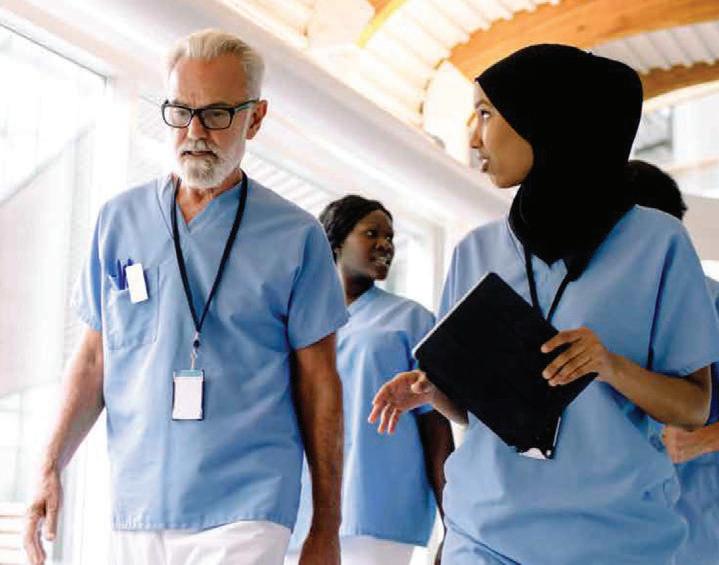
Royal Philips, a global leader in health technology, recently published it annual Future Health Index (FHI) 2023 Saudi Arabia report: Taking Healthcare Everywhere. Now in its eighth year, the Future Health Index is based on proprietary research across 14 countries, including Saudi Arabia, making it the largest global survey of its kind to analyse the current and future priorities of healthcare leaders worldwide.
The FHI 2023 Saudi Arabia report provides a clear indication of strong momentum in innovation and digital transformation within the Kingdom’s healthcare
system. Saudi Arabian Healthcare leaders and younger healthcare professionals are aligned in their vision to innovate new models of care delivery that meet patients where they are. Building on the advancements in the post-pandemic era, healthcare leaders are now prioritizing the implementation of virtual care and AI solutions to address staff shortages and furthering sustainability. These developments, along with a strong inclination towards strategic partnerships, mark critical steps in the Kingdom’s journey towards Vision 2030, emphasizing a commitment to improving
patient care through innovative and technologically advanced healthcare models.
Mohammad Mostafa, General Manager, Health Systems, Philips Middle East, Türkiye and Africa, commented: “The Future Health Index 2023 underscores Saudi Arabia’s transformative vision for healthcare. The nation is investing heavily in AI, recognizing the unmatched potential of virtual care while also taking steps to make healthcare more sustainable, understanding the indispensable role of partnerships in achieving this and ultimately improving and revolutionizing patient care.”
The Future Health Index 2023 Saudi Arabia report highlights three important focus areas for healthcare leaders that will help them enhance care delivery and increase efficiencies within their facilities:
1.
Digital health technologies are emerging as the lynchpin to tackle staff shortages. With 63% of Saudi Arabian healthcare leaders using or planning to use digital health technologies, the future appears promising. Younger healthcare professionals also see the potential benefits, recognizing the potential of data portability, advanced diagnostics, and state-of-the-art AI solutions to improve their work satisfaction. Along with the adoption of advanced technology solutions, 46% of Saudi Arabia’s healthcare leaders are forging partnerships with health technology companies, and an equal percentage are engaging with NGOs and charity organizations, to help reduce the impact of workforce shortages.
Saudi’s healthcare leaders are turning to technology, aiming to increase productivity and satisfaction among healthcare practitioners, as well as external partnerships. Alongside enhancing care delivery and increasing efficiencies, such investments play a crucial role in attracting and retaining talent.
In Saudi Arabia, the patient-centric paradigm is gaining momentum. Saudi Arabian healthcare leaders are championing this shift with a notable (30%) investment in new, more innovative technology. Further evidence of this trend comes from the consensus among healthcare leaders (57%) and younger healthcare professionals (56%), who believe in the transformative potential of new care delivery models, in that they’re likely to bring more affordable care or better value for money. These positive sentiments are further highlighted
by 53% of all respondents combined responding that improved patient safety was a likely outcome of new care delivery models. A staggering 77% of leaders are currently harnessing the power of AI, an increase from 46% in 2022, and 73% are offering a form of virtual care. Digital technologies, including AI, are also a key focus of the Kingdom’s Health Sector Transformation Program, setting a precedent for ongoing innovation. With an eye toward sustained progress, an impressive (96%) of healthcare leaders are poised to expand their investments in AI, up from 66% in 2022, ensuring that Saudi Arabia remains at the forefront of healthcare technology.
3. Partnering to support communities and the environment
Collaboration within the healthcare sector continues to be a cornerstone of Saudi Arabia’s strategic plan for healthcare advancement. A notable 38% of healthcare leaders are gearing up to forge partnerships with healthcare technology companies in the near future. Meanwhile, younger healthcare professionals would like their hospital/healthcare facility to build partnerships outside the conventional bounds of the healthcare sector in order to improve patient outcome.
Saudi Arabia’s healthcare leaders and younger healthcare professionals also signal an opportunity for wider ecosystem collaboration to improve sustainability in the face of climate change. As environmental sustainability becomes a primary focus in healthcare, these leaders are employing specific strategies to navigate these challenges effectively. These include setting clear and ambitious sustainability targets while measuring progress, recruiting more staff with specialized skills to advance these initiatives, consulting or working with third parties to deliver or support sustainability programmes, and sharing best practice examples and learning from peers.
Download the report

Drawing on insights from the global Future Health Index (FHI) 2023 report, Saudi Arabia isn’t merely aligning with global healthcare trends – in many respects it is leading them. The unwavering momentum provided by Saudi Vision 2030’s Health Sector Transformation Programme < https://www.vision2030.gov.sa/v2030/vrps/hstp > promises an exciting future for the nation’s healthcare landscape.
Mostafa noted: “As we delve into the Saudi Arabia-specific insights of the FHI 2023, it is clear that the Kingdom is not merely adapting to change but actively shaping the future of healthcare. The integration of AI, the emphasis on sustainability, and the collaborative spirit underscore the Kingdom’s progressive stance.”
About the FHI 2023 report
The FHI 2023 report is based on proprietary research among nearly 3,000 healthcare leaders and younger healthcare professionals conducted in 14 countries. Learn more about the Future Health Index methodology < https://www.philips.com/ a-w/about/news/future-health-index/researchmethodology.html >.
Future Health Index 2023 Saudi Arabia report: Taking Healthcare Everywhere https://www.philips.sa/en/a-w/about/news/future-health-index/reports/2023/taking-healthcare-everywhere.html

